:max_bytes(150000):strip_icc():format(webp)/the-10-best-password-managers-of-2022-6543213-7650bf3ab2eb41a08dbee8713ce811e3.jpg)
New 2024 Approved Top 7 Watermark-Free Video Combiners

Top 7 Watermark-Free Video Combiners
Sometimes, when delving into the vast space of internet and trying to find the perfect online platforms or software in order to edit some videos, it might get frustrating to find only the ones with watermark. But of course, the resources are endless and in case we have some information, we can easily access the free video editing platforms which give us the opportunity to edit our videos without undesired logos on them. In this case, we will be discussing 6 video mergers without watermark, and the way we can use them – the tools and features they offer, and how we can get the best out of them.
- Photos by Microsoft
If you are too lazy to get high-quality results using popular video editors, like Filmora, try Photos App. It is a built-in program that usually opens your images on Windows 10, but you can also use it for merging your videos. And guess what? Since it comes within the system, all the features, although limited, are absolutely free.
How to Merge Videos on Windows using Photos App?
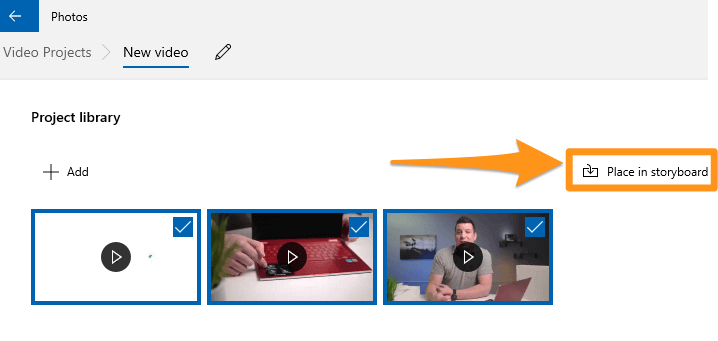
These are the steps to combine multiple clips in Windows 10 with Photos App.
Step 1: Open Photos App
Go to the ‘Start’ menu, find Photos App, and click to open it.
Step 2: Make a New Project
Click the ‘New video project’ (big blue box) under the ‘Video Projects’ tab. Alternatively, you can click the ‘New video’ button and select the ‘New video project’ option from the dropdown menu.
Step 3: Add Clips
Look for the text ‘Project library.’ Then click the ‘+ Add’ button. This will open a new window so you can select the clips you want to combine. Also, import videos one by one in a proper sequence because you cannot arrange them later.
Step 4: Make a Storyboard
After importing all the shots, you want to merge, click the ‘Place in storyboard’ button. This option will add all the chosen clips to your project’s storyboard.
- Fastreel by Movavi
Fastreel is a free online video editor. It is extremely easy to use right away, without installing anything. So, on Fastreel, one can edit videos or use online templates in the browser itself. Actually, the first tool we see in the list of Fastreel tools is to merge a video; then, it can be used in order to compress, make, cut, and create a video. On fastreel, you can add a watermark to a video, if wanted - so, it is very voluntary. As for the merging of a video, when this tool is chosen, it’s pretty simple to understand the steps – you can just drop/add multiple files right away.

The format must be either of the listed: MP4, MOV, MKV, AVI, and WMV, and the total size mustn’t exceed 500 MB. Then, in order to add some transitions, a style can be chosen from the drop-down menu, and after that, you should hit on Continue button to stitch the videos together. For the last step, you can export the result by selecting Download option.
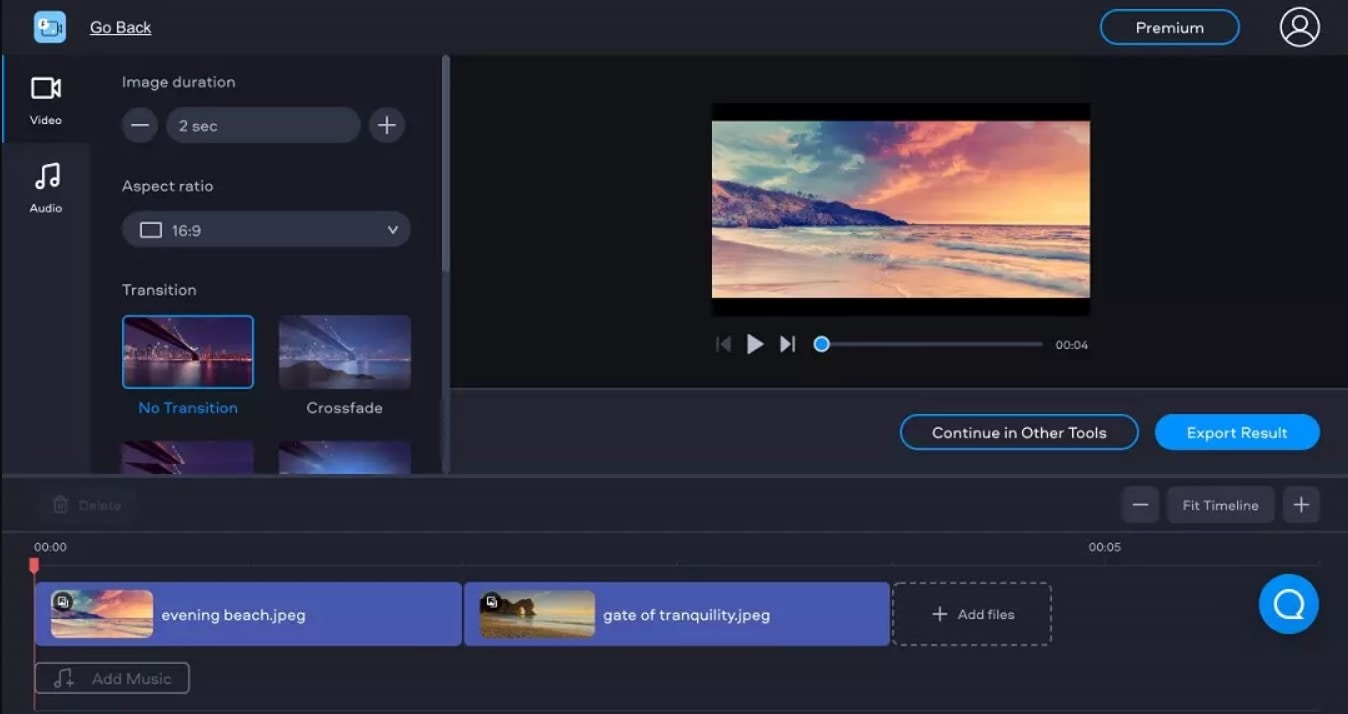
- Free Video Cutter Joiner
Free Video Cutter Joiner – the name already explains it all by itself! This is a free video merger which will not add watermark on your video. The software needs to be downloaded, and contributes to quickly cutting and joining videos. Free Video Cutter Joiner has no size limits – it can cut and merge videos with large file sizes without any trouble, and speed of it to do so is quite fast. It supports several file formats, such as AVI, MPEG, WMV, 3GP FLV, MP4, WMV, MOV, VOB, etc.
So, once downloaded, you will see how user-friendly and straightforward the software is: it shows two of its features right away – video cutter and video joiner. You choose which one you are about to use – so, in our case, video joiner.

Then, you should click the the “+” icon, which lets you add files from your PC.

Then, hit on the Join button, and choose Indirect Join. Hitting on Start Join will start merging all the uploaded videos, and, wait a little until the process has been completed.
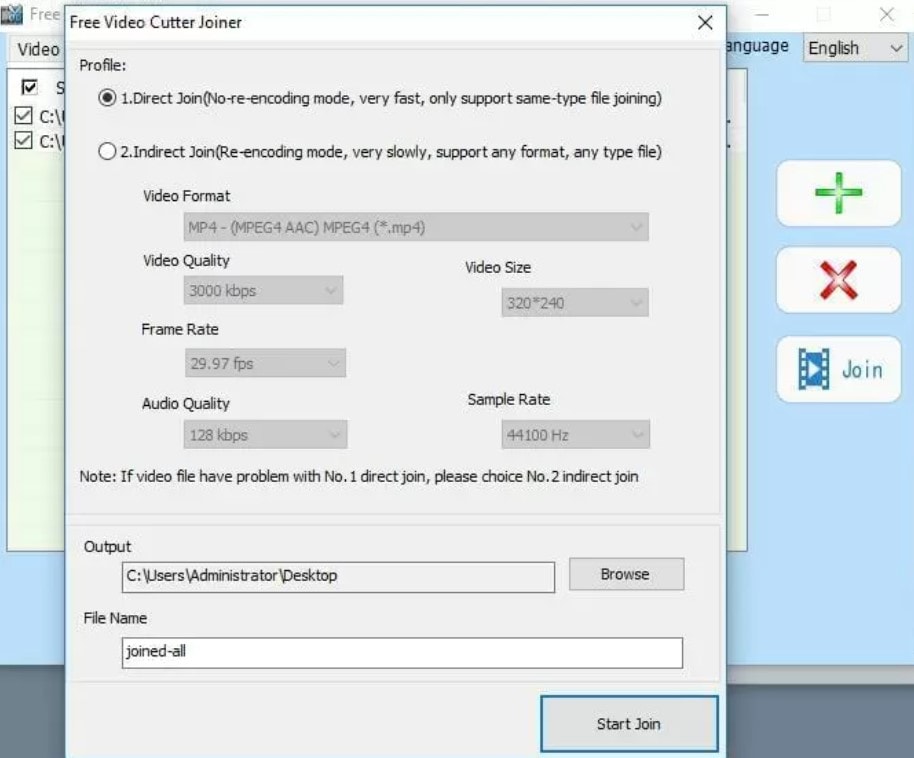
- Clideo
Clideo is the online platform that declares that it makes it super easy to edit all your video files, images and GIFs, and is totally free. It gives us the opportunities to: merge, compress, resize, cut, make, crop, speed, rotate, add music to, loop, flip, reverse, mute, filter, and adjust the videos. Add subtitles, make memes, create slideshows, etc. Therefore, it’s pretty rich in its tools and features.
As for merging videos, much like Fastreel, Clideo is pretty straightforward. You just click on the mentioned tool, and then easily choose files you would like to combine – you can merge any amount of video clips there. Several files can be chosen at the same time, or they can be added one by one.

Then it will take you to the editor, where you can join the videos. It’s possible to rearrange the files, by using drag-and-drop until they’re in the desired order. You can also add images and set duration from them, add audio, change its length and volume. The last step is choosing the aspect ratio and clicking the Export button. You can watch the preview of your result and then click on Download if you are satisfied with the merged file.

- Typito
Typito is a platform to merge videos online, as well as Fastreel and Clideo. It is free, and mostly aims to create combinations one can use to post on social network such as Instagram, Facebook, and Youtube. Typito supports a great many formats, some of them being MP4, AVI, FLV and WMV. You can edit your videos before merging them by trimming, cropping and resizing, and also add transition effects and music. It quickly combines footage, doesn’t watermark the videos, has brand kit of colors, fonts and style. It can also create collection of images, which is used for making Youtube compilation at most times.
To merge videos, you should choose the tool, then Get Started, and register and sign in first.
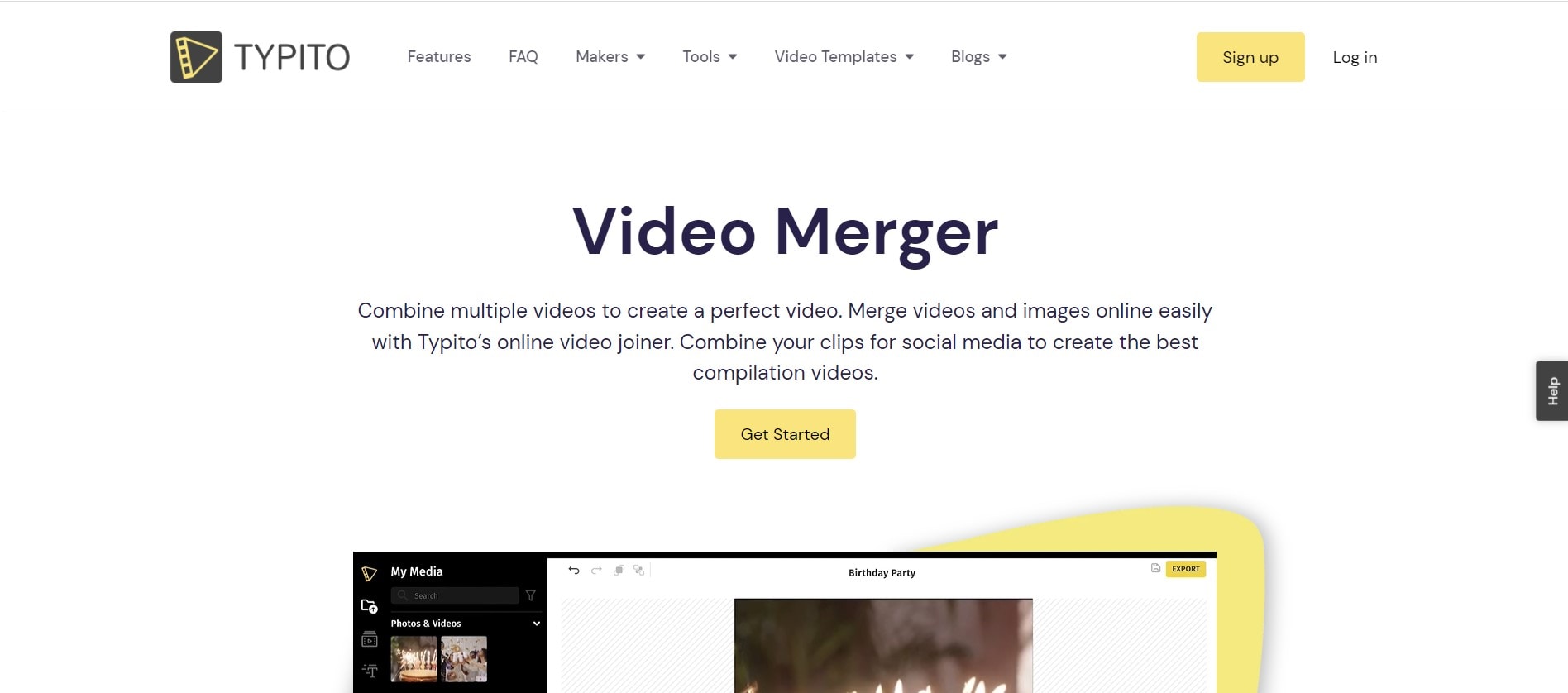
Then click on New Project, choose a video format (the platform offers you the list of the most popular ones), and it will take you to the editor, where you start off by adding media.

Drag and drop images or videos that you want to combine into a single video. You can also click to upload media files from your system or browse our Stock Media library for high-quality stock photos and video. Then, you can put your video clips in order, and work on it, if you want to use different tools, such as: edit, crop, trim, or resize them, as well as add text captions, images, and transitions. After you have previewed your video, you can click on the export button in the top right corner, and then, your merged video will be ready to be shared.
- Online UniConverter
Online UniConverter is the next online platform giving us the chance to merge our videos without watermark. It is an online analogue of Wondershare UniConverter, and is a very powerful platform, where you can trim, split, rotate, adjust, and download videos in HD quality. UniConverter supports numerous video formats, including MP4, AVI, MOV, MP3, WEBM. Online UniConverter offers various transitions and aspect ratios to fit the screen.
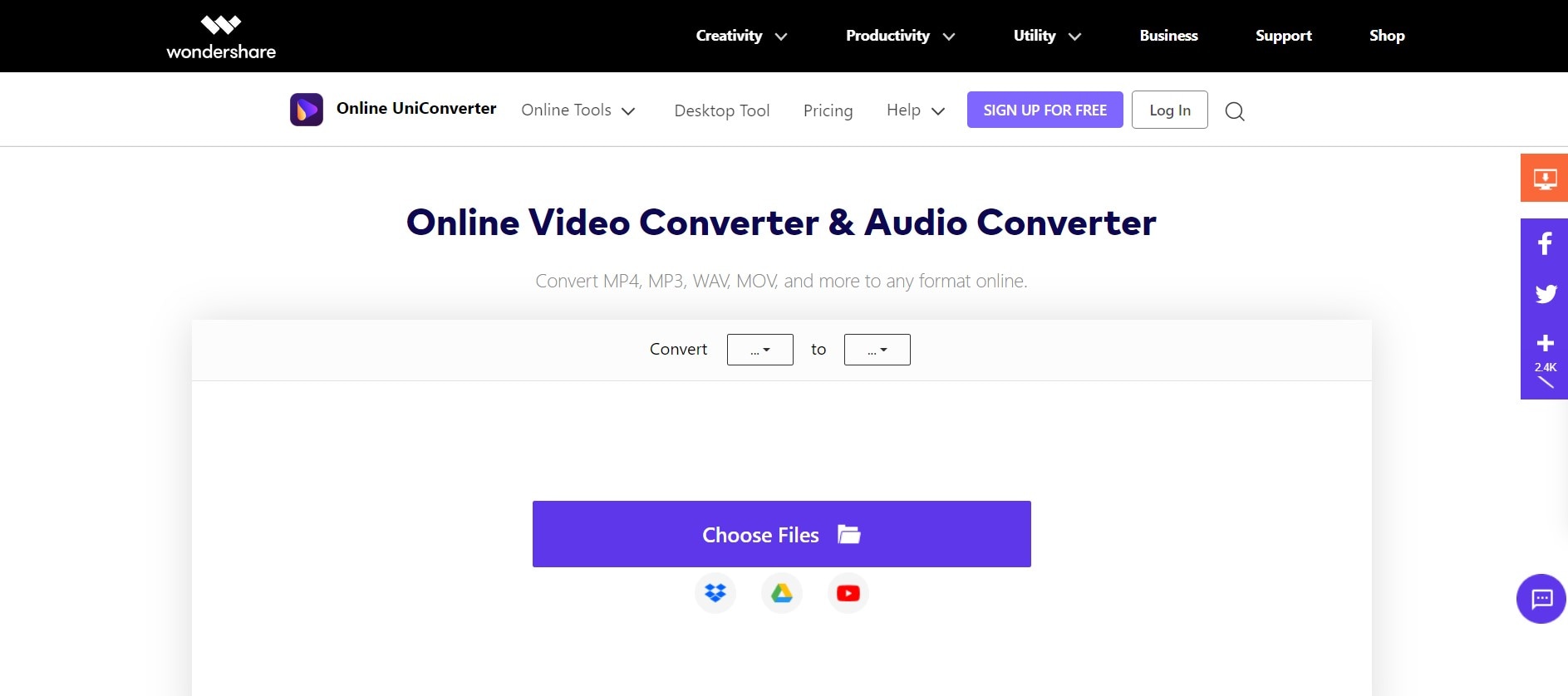
The web-site has lots of tools and features to offer: in the description of it, it reads: video converter, video compressor, video editor, audio converter, audio compressor, audio cutter, GIF maker, YouTube thumbnail, and image resizer. Importing media to the online UniConverter is extremely easy, and combining videos turns out to be a quick process, too.
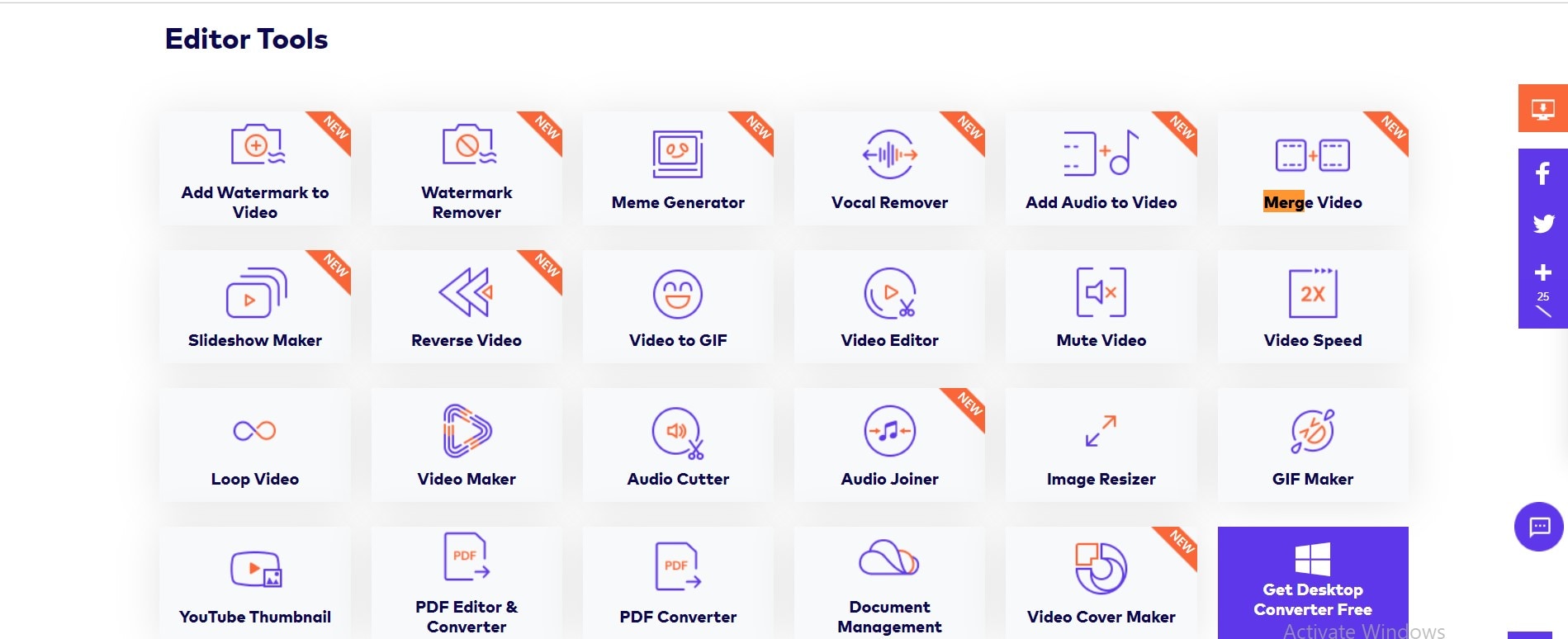
Anyway, if you want to combine a lot of files and the size of them all exceeds 100 MB, you will not be able to use Online Uniconverter for that. It supports the video no more than 100 MB and suggests using Wondershare UniConverter (originally Wondershare Video Converter Ultimate) for Desktop.
- Wondershare Filmora
Last but not least – Filmora Video Editor ! Even it differs from other abovementioned video mergers, as in it is not totally free and adds a Filmora logo on exported project, it’s a great suggestion for people who want to make their videos look great with the help of various tools. When a user is ready to pay, Filmora offers a subscription model, and for a bit more, one can get a permanent license. The software costs $51.99 per year or $79.99 for an outright purchase (prices are regularly discounted).
Wondershare Filmora has a clear and pleasing interface, offers trimming, transitions, overlays, several effects, as well as some more advanced and modern features, such as motion tracking. For this one particular software, we will be offering a step by step guide about how to merge videos there.
For Win 7 or later (64-bit)
For macOS 10.14 or later
- Open the program.
- Choose Import Media Files Here.

- Choose your
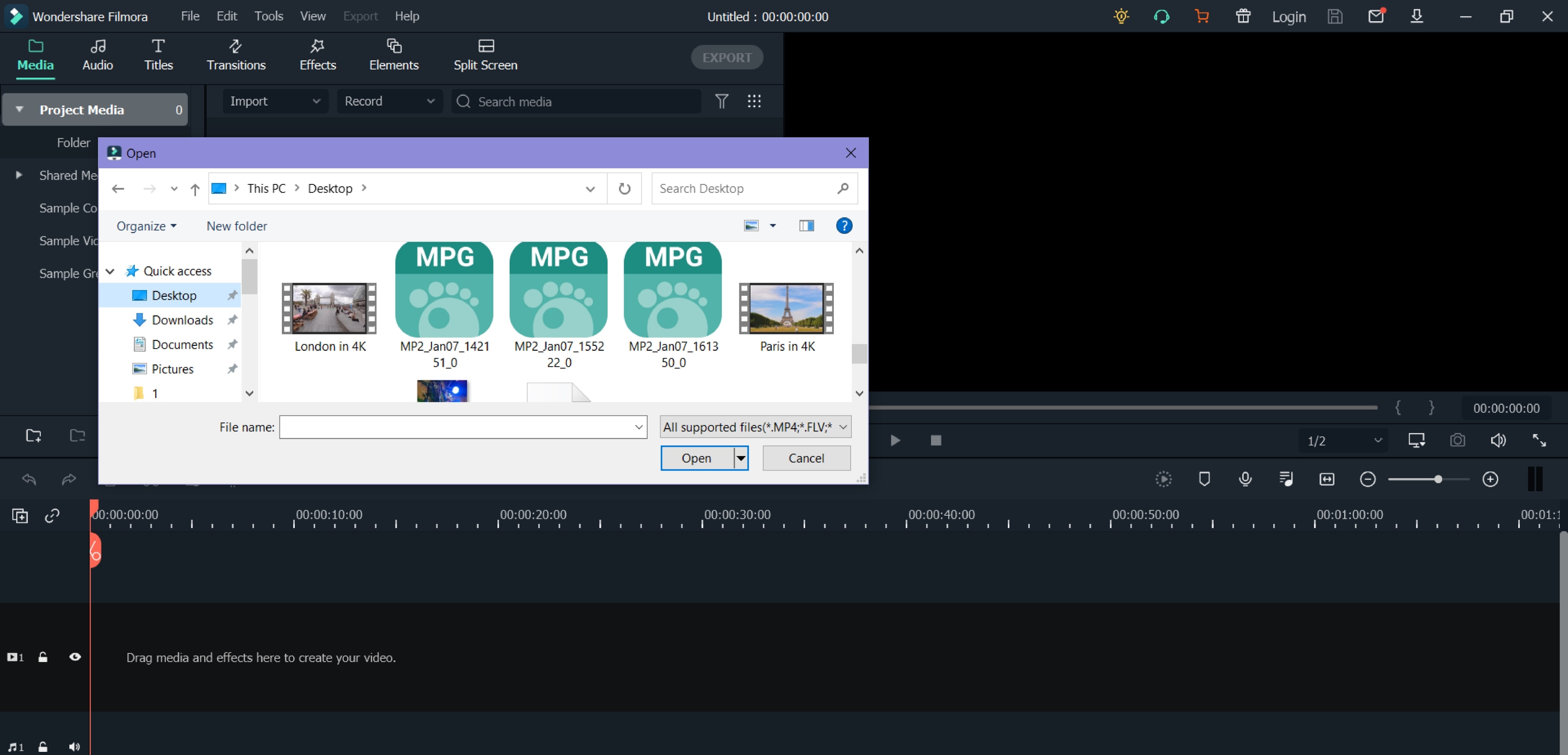
- We can click and drag, essentially, “insert” a video in a sequence below. The Linear Timeline allows us to understand exactly when a video clip ends and when a new one starts.

- Accordingly, we can make one video “sit” next to another. If we want or need it, we will add the third video clip, fourth, and so on.
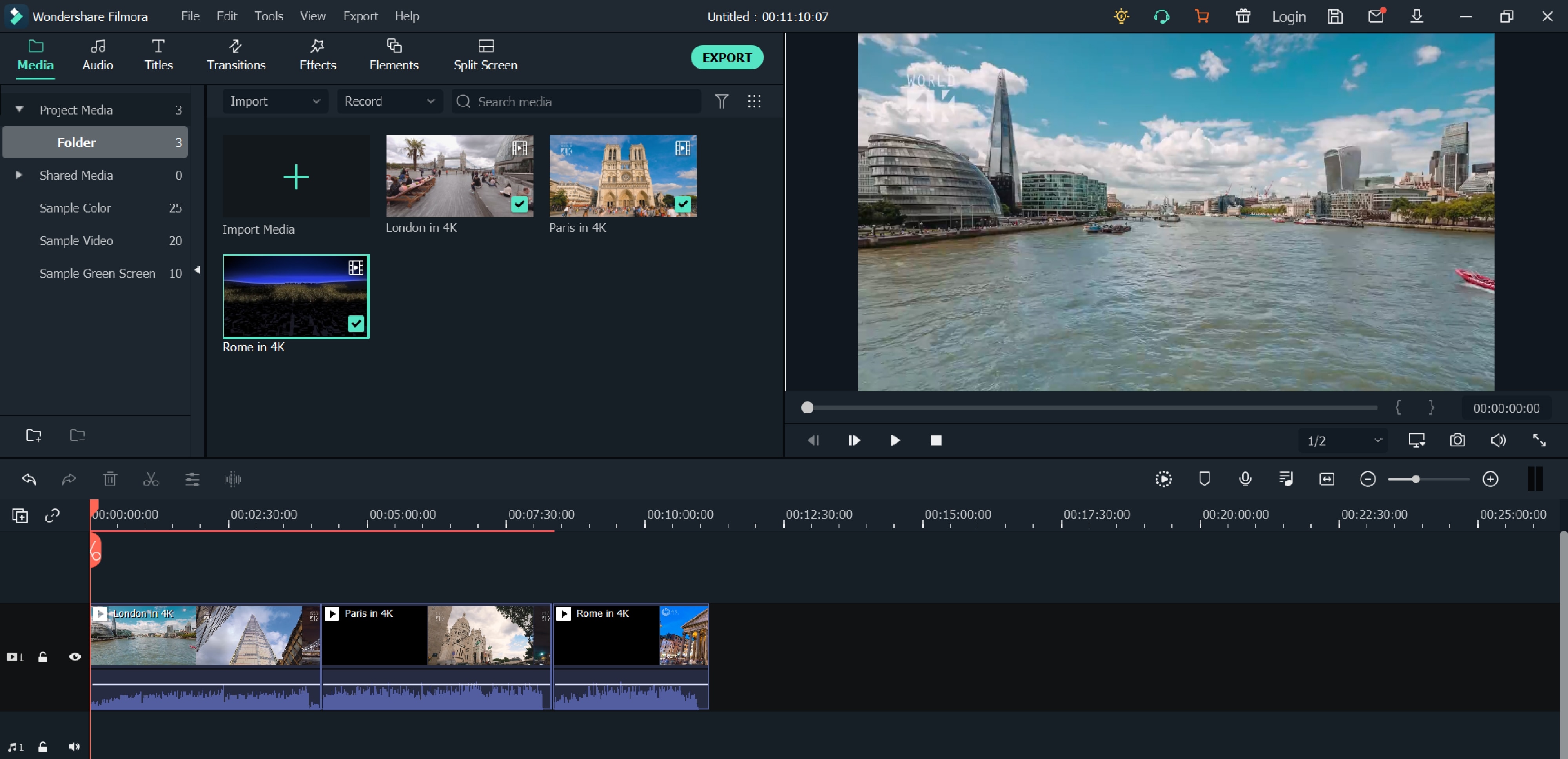
- We can view the entire video and save the video afterwards.
- Start to save video - we make sure the result is exactly what we wanted, find the Export button above the timeline and click on it.
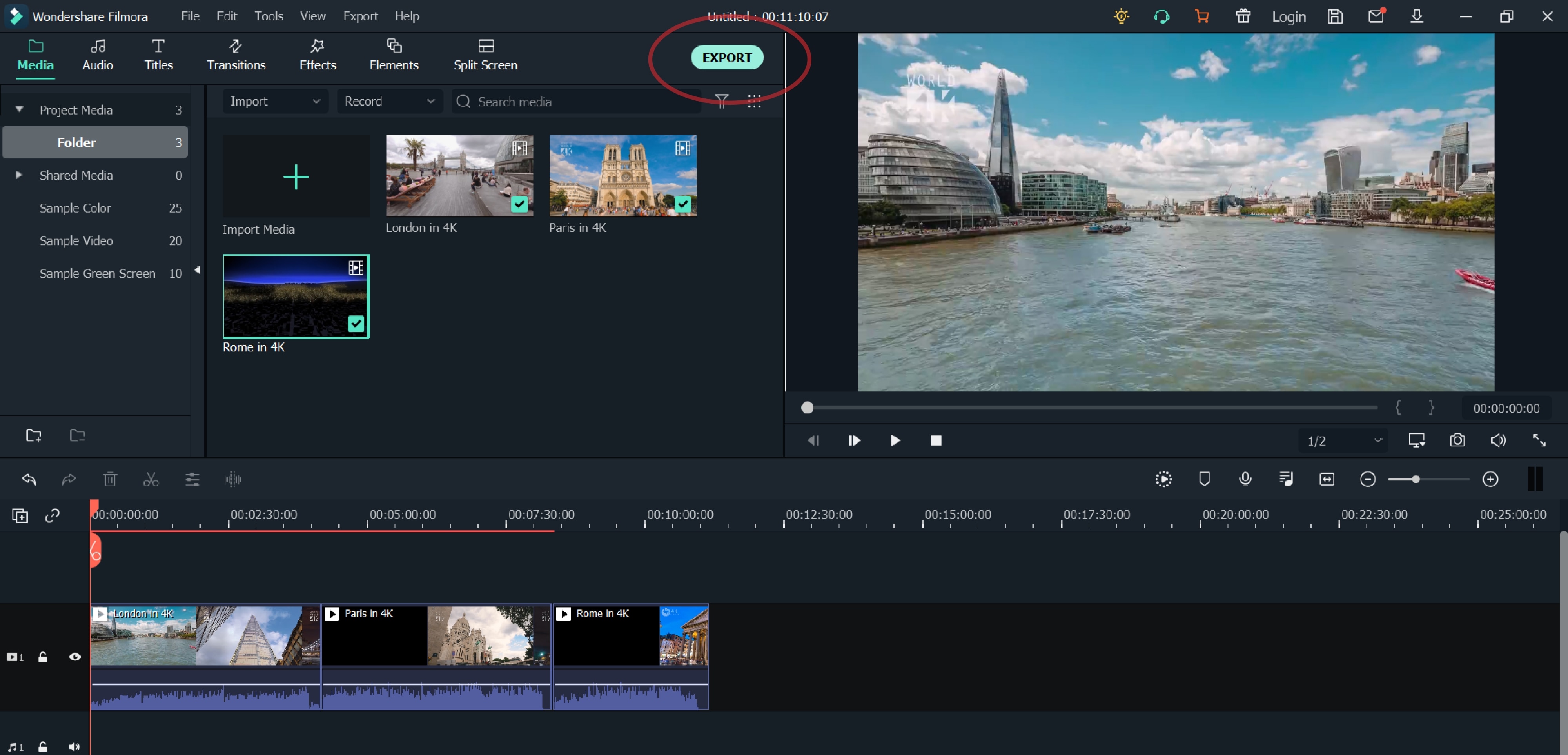
- In the opened window, on the left side, to be precise, if we observe well, we can already choose in which format we want to save our clip. On the right we can indicate what name we want to give to our video; The location where we want to store it; Also, we see the resolution (which we can modify freely after clicking on Settings); Size; Duration.
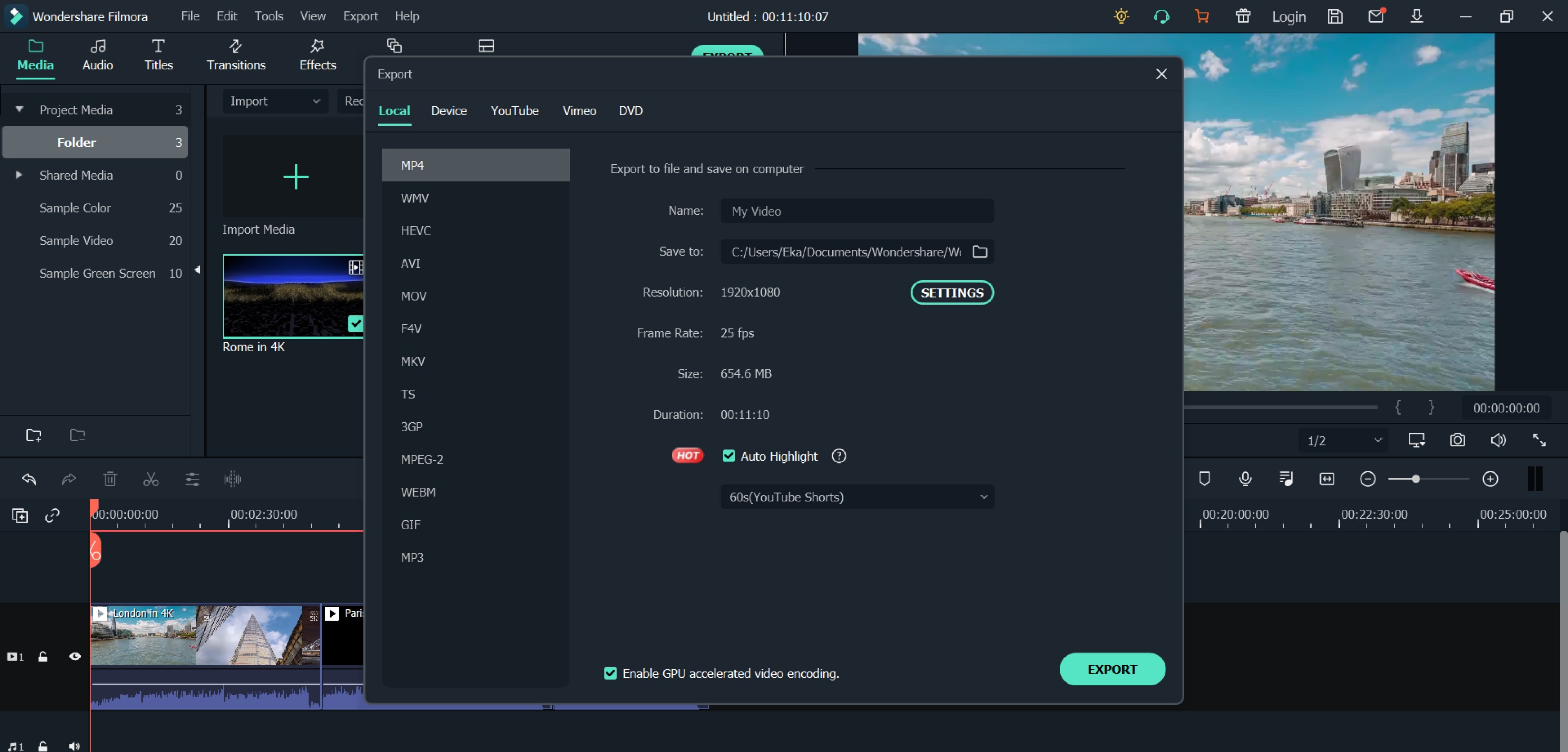
- In Settings, we can decide how much quality the video should have, how many kbps will be the Bit Rate, how many fps the Frame Rate should be, etc., but most likely, beginners will not need to change all this.
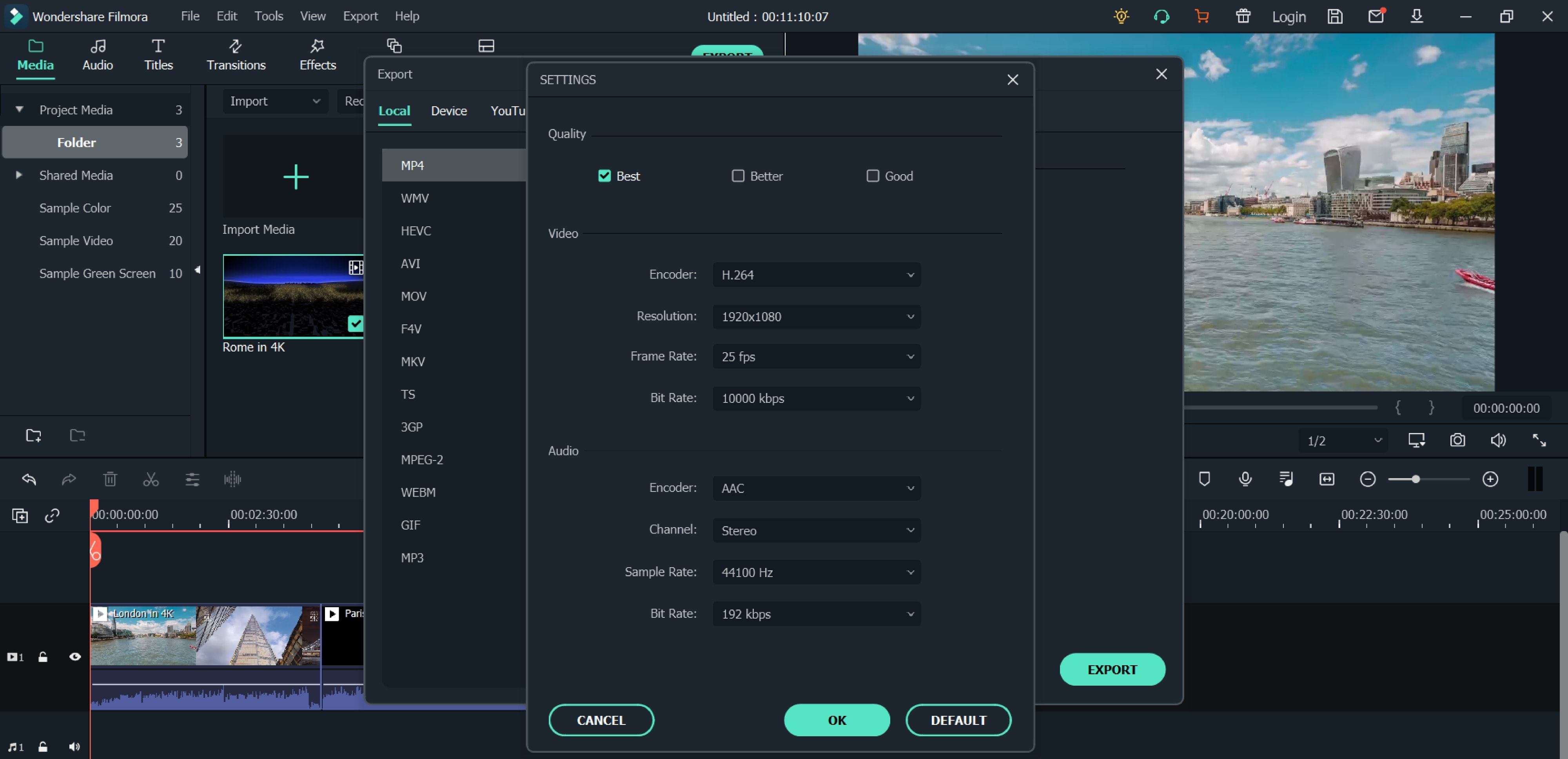
- After selecting everything, right-click on the Export button in the lower right corner of the window and the program will start saving the material.
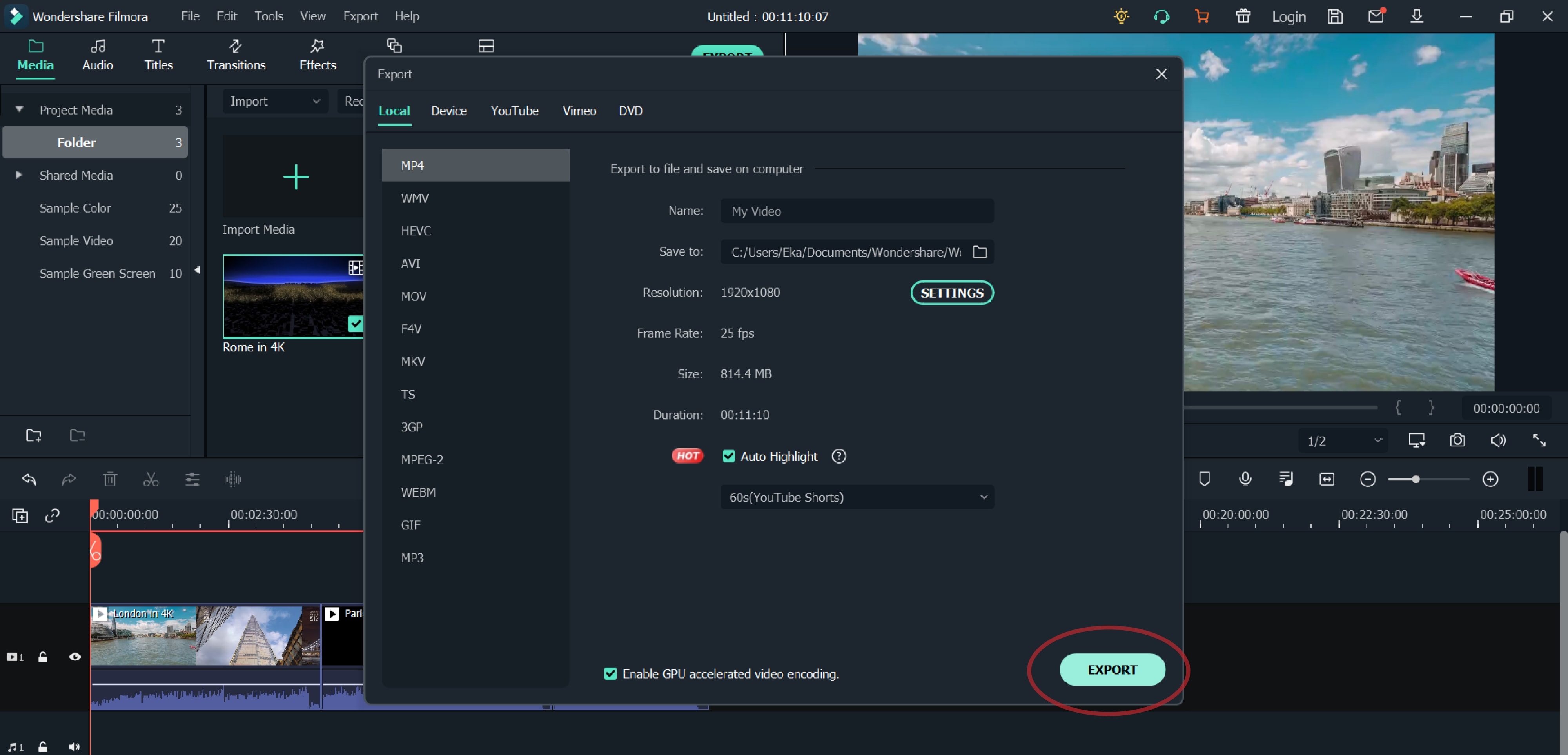

So, in this article, we introduced some online platforms and software for you to use if you would like to merge videos and combine them into one. These are: Fastreel, Free Video Cutter Joiner, Clideo, Typito, Online UniConverter, Wondershare Filmora. It’s up to you which one you would like to choose to merge your videos or edit them in any other way, but you can try either of them and choose to your own liking – even so, of course, there are some other video mergers worth considering, that we might mention in the coming articles. Before then, enjoy with free video editors, without watermark!
If you are too lazy to get high-quality results using popular video editors, like Filmora, try Photos App. It is a built-in program that usually opens your images on Windows 10, but you can also use it for merging your videos. And guess what? Since it comes within the system, all the features, although limited, are absolutely free.
How to Merge Videos on Windows using Photos App?

These are the steps to combine multiple clips in Windows 10 with Photos App.
Step 1: Open Photos App
Go to the ‘Start’ menu, find Photos App, and click to open it.
Step 2: Make a New Project
Click the ‘New video project’ (big blue box) under the ‘Video Projects’ tab. Alternatively, you can click the ‘New video’ button and select the ‘New video project’ option from the dropdown menu.
Step 3: Add Clips
Look for the text ‘Project library.’ Then click the ‘+ Add’ button. This will open a new window so you can select the clips you want to combine. Also, import videos one by one in a proper sequence because you cannot arrange them later.
Step 4: Make a Storyboard
After importing all the shots, you want to merge, click the ‘Place in storyboard’ button. This option will add all the chosen clips to your project’s storyboard.
- Fastreel by Movavi
Fastreel is a free online video editor. It is extremely easy to use right away, without installing anything. So, on Fastreel, one can edit videos or use online templates in the browser itself. Actually, the first tool we see in the list of Fastreel tools is to merge a video; then, it can be used in order to compress, make, cut, and create a video. On fastreel, you can add a watermark to a video, if wanted - so, it is very voluntary. As for the merging of a video, when this tool is chosen, it’s pretty simple to understand the steps – you can just drop/add multiple files right away.

The format must be either of the listed: MP4, MOV, MKV, AVI, and WMV, and the total size mustn’t exceed 500 MB. Then, in order to add some transitions, a style can be chosen from the drop-down menu, and after that, you should hit on Continue button to stitch the videos together. For the last step, you can export the result by selecting Download option.

- Free Video Cutter Joiner
Free Video Cutter Joiner – the name already explains it all by itself! This is a free video merger which will not add watermark on your video. The software needs to be downloaded, and contributes to quickly cutting and joining videos. Free Video Cutter Joiner has no size limits – it can cut and merge videos with large file sizes without any trouble, and speed of it to do so is quite fast. It supports several file formats, such as AVI, MPEG, WMV, 3GP FLV, MP4, WMV, MOV, VOB, etc.
So, once downloaded, you will see how user-friendly and straightforward the software is: it shows two of its features right away – video cutter and video joiner. You choose which one you are about to use – so, in our case, video joiner.

Then, you should click the the “+” icon, which lets you add files from your PC.

Then, hit on the Join button, and choose Indirect Join. Hitting on Start Join will start merging all the uploaded videos, and, wait a little until the process has been completed.

- Clideo
Clideo is the online platform that declares that it makes it super easy to edit all your video files, images and GIFs, and is totally free. It gives us the opportunities to: merge, compress, resize, cut, make, crop, speed, rotate, add music to, loop, flip, reverse, mute, filter, and adjust the videos. Add subtitles, make memes, create slideshows, etc. Therefore, it’s pretty rich in its tools and features.
As for merging videos, much like Fastreel, Clideo is pretty straightforward. You just click on the mentioned tool, and then easily choose files you would like to combine – you can merge any amount of video clips there. Several files can be chosen at the same time, or they can be added one by one.

Then it will take you to the editor, where you can join the videos. It’s possible to rearrange the files, by using drag-and-drop until they’re in the desired order. You can also add images and set duration from them, add audio, change its length and volume. The last step is choosing the aspect ratio and clicking the Export button. You can watch the preview of your result and then click on Download if you are satisfied with the merged file.

- Typito
Typito is a platform to merge videos online, as well as Fastreel and Clideo. It is free, and mostly aims to create combinations one can use to post on social network such as Instagram, Facebook, and Youtube. Typito supports a great many formats, some of them being MP4, AVI, FLV and WMV. You can edit your videos before merging them by trimming, cropping and resizing, and also add transition effects and music. It quickly combines footage, doesn’t watermark the videos, has brand kit of colors, fonts and style. It can also create collection of images, which is used for making Youtube compilation at most times.
To merge videos, you should choose the tool, then Get Started, and register and sign in first.

Then click on New Project, choose a video format (the platform offers you the list of the most popular ones), and it will take you to the editor, where you start off by adding media.

Drag and drop images or videos that you want to combine into a single video. You can also click to upload media files from your system or browse our Stock Media library for high-quality stock photos and video. Then, you can put your video clips in order, and work on it, if you want to use different tools, such as: edit, crop, trim, or resize them, as well as add text captions, images, and transitions. After you have previewed your video, you can click on the export button in the top right corner, and then, your merged video will be ready to be shared.
- Online UniConverter
Online UniConverter is the next online platform giving us the chance to merge our videos without watermark. It is an online analogue of Wondershare UniConverter, and is a very powerful platform, where you can trim, split, rotate, adjust, and download videos in HD quality. UniConverter supports numerous video formats, including MP4, AVI, MOV, MP3, WEBM. Online UniConverter offers various transitions and aspect ratios to fit the screen.

The web-site has lots of tools and features to offer: in the description of it, it reads: video converter, video compressor, video editor, audio converter, audio compressor, audio cutter, GIF maker, YouTube thumbnail, and image resizer. Importing media to the online UniConverter is extremely easy, and combining videos turns out to be a quick process, too.

Anyway, if you want to combine a lot of files and the size of them all exceeds 100 MB, you will not be able to use Online Uniconverter for that. It supports the video no more than 100 MB and suggests using Wondershare UniConverter (originally Wondershare Video Converter Ultimate) for Desktop.
- Wondershare Filmora
Last but not least – Filmora Video Editor ! Even it differs from other abovementioned video mergers, as in it is not totally free and adds a Filmora logo on exported project, it’s a great suggestion for people who want to make their videos look great with the help of various tools. When a user is ready to pay, Filmora offers a subscription model, and for a bit more, one can get a permanent license. The software costs $51.99 per year or $79.99 for an outright purchase (prices are regularly discounted).
Wondershare Filmora has a clear and pleasing interface, offers trimming, transitions, overlays, several effects, as well as some more advanced and modern features, such as motion tracking. For this one particular software, we will be offering a step by step guide about how to merge videos there.
For Win 7 or later (64-bit)
For macOS 10.14 or later
- Open the program.
- Choose Import Media Files Here.

- Choose your

- We can click and drag, essentially, “insert” a video in a sequence below. The Linear Timeline allows us to understand exactly when a video clip ends and when a new one starts.

- Accordingly, we can make one video “sit” next to another. If we want or need it, we will add the third video clip, fourth, and so on.

- We can view the entire video and save the video afterwards.
- Start to save video - we make sure the result is exactly what we wanted, find the Export button above the timeline and click on it.

- In the opened window, on the left side, to be precise, if we observe well, we can already choose in which format we want to save our clip. On the right we can indicate what name we want to give to our video; The location where we want to store it; Also, we see the resolution (which we can modify freely after clicking on Settings); Size; Duration.

- In Settings, we can decide how much quality the video should have, how many kbps will be the Bit Rate, how many fps the Frame Rate should be, etc., but most likely, beginners will not need to change all this.

- After selecting everything, right-click on the Export button in the lower right corner of the window and the program will start saving the material.


So, in this article, we introduced some online platforms and software for you to use if you would like to merge videos and combine them into one. These are: Fastreel, Free Video Cutter Joiner, Clideo, Typito, Online UniConverter, Wondershare Filmora. It’s up to you which one you would like to choose to merge your videos or edit them in any other way, but you can try either of them and choose to your own liking – even so, of course, there are some other video mergers worth considering, that we might mention in the coming articles. Before then, enjoy with free video editors, without watermark!
If you are too lazy to get high-quality results using popular video editors, like Filmora, try Photos App. It is a built-in program that usually opens your images on Windows 10, but you can also use it for merging your videos. And guess what? Since it comes within the system, all the features, although limited, are absolutely free.
How to Merge Videos on Windows using Photos App?

These are the steps to combine multiple clips in Windows 10 with Photos App.
Step 1: Open Photos App
Go to the ‘Start’ menu, find Photos App, and click to open it.
Step 2: Make a New Project
Click the ‘New video project’ (big blue box) under the ‘Video Projects’ tab. Alternatively, you can click the ‘New video’ button and select the ‘New video project’ option from the dropdown menu.
Step 3: Add Clips
Look for the text ‘Project library.’ Then click the ‘+ Add’ button. This will open a new window so you can select the clips you want to combine. Also, import videos one by one in a proper sequence because you cannot arrange them later.
Step 4: Make a Storyboard
After importing all the shots, you want to merge, click the ‘Place in storyboard’ button. This option will add all the chosen clips to your project’s storyboard.
- Fastreel by Movavi
Fastreel is a free online video editor. It is extremely easy to use right away, without installing anything. So, on Fastreel, one can edit videos or use online templates in the browser itself. Actually, the first tool we see in the list of Fastreel tools is to merge a video; then, it can be used in order to compress, make, cut, and create a video. On fastreel, you can add a watermark to a video, if wanted - so, it is very voluntary. As for the merging of a video, when this tool is chosen, it’s pretty simple to understand the steps – you can just drop/add multiple files right away.

The format must be either of the listed: MP4, MOV, MKV, AVI, and WMV, and the total size mustn’t exceed 500 MB. Then, in order to add some transitions, a style can be chosen from the drop-down menu, and after that, you should hit on Continue button to stitch the videos together. For the last step, you can export the result by selecting Download option.

- Free Video Cutter Joiner
Free Video Cutter Joiner – the name already explains it all by itself! This is a free video merger which will not add watermark on your video. The software needs to be downloaded, and contributes to quickly cutting and joining videos. Free Video Cutter Joiner has no size limits – it can cut and merge videos with large file sizes without any trouble, and speed of it to do so is quite fast. It supports several file formats, such as AVI, MPEG, WMV, 3GP FLV, MP4, WMV, MOV, VOB, etc.
So, once downloaded, you will see how user-friendly and straightforward the software is: it shows two of its features right away – video cutter and video joiner. You choose which one you are about to use – so, in our case, video joiner.

Then, you should click the the “+” icon, which lets you add files from your PC.

Then, hit on the Join button, and choose Indirect Join. Hitting on Start Join will start merging all the uploaded videos, and, wait a little until the process has been completed.

- Clideo
Clideo is the online platform that declares that it makes it super easy to edit all your video files, images and GIFs, and is totally free. It gives us the opportunities to: merge, compress, resize, cut, make, crop, speed, rotate, add music to, loop, flip, reverse, mute, filter, and adjust the videos. Add subtitles, make memes, create slideshows, etc. Therefore, it’s pretty rich in its tools and features.
As for merging videos, much like Fastreel, Clideo is pretty straightforward. You just click on the mentioned tool, and then easily choose files you would like to combine – you can merge any amount of video clips there. Several files can be chosen at the same time, or they can be added one by one.

Then it will take you to the editor, where you can join the videos. It’s possible to rearrange the files, by using drag-and-drop until they’re in the desired order. You can also add images and set duration from them, add audio, change its length and volume. The last step is choosing the aspect ratio and clicking the Export button. You can watch the preview of your result and then click on Download if you are satisfied with the merged file.

- Typito
Typito is a platform to merge videos online, as well as Fastreel and Clideo. It is free, and mostly aims to create combinations one can use to post on social network such as Instagram, Facebook, and Youtube. Typito supports a great many formats, some of them being MP4, AVI, FLV and WMV. You can edit your videos before merging them by trimming, cropping and resizing, and also add transition effects and music. It quickly combines footage, doesn’t watermark the videos, has brand kit of colors, fonts and style. It can also create collection of images, which is used for making Youtube compilation at most times.
To merge videos, you should choose the tool, then Get Started, and register and sign in first.

Then click on New Project, choose a video format (the platform offers you the list of the most popular ones), and it will take you to the editor, where you start off by adding media.

Drag and drop images or videos that you want to combine into a single video. You can also click to upload media files from your system or browse our Stock Media library for high-quality stock photos and video. Then, you can put your video clips in order, and work on it, if you want to use different tools, such as: edit, crop, trim, or resize them, as well as add text captions, images, and transitions. After you have previewed your video, you can click on the export button in the top right corner, and then, your merged video will be ready to be shared.
- Online UniConverter
Online UniConverter is the next online platform giving us the chance to merge our videos without watermark. It is an online analogue of Wondershare UniConverter, and is a very powerful platform, where you can trim, split, rotate, adjust, and download videos in HD quality. UniConverter supports numerous video formats, including MP4, AVI, MOV, MP3, WEBM. Online UniConverter offers various transitions and aspect ratios to fit the screen.

The web-site has lots of tools and features to offer: in the description of it, it reads: video converter, video compressor, video editor, audio converter, audio compressor, audio cutter, GIF maker, YouTube thumbnail, and image resizer. Importing media to the online UniConverter is extremely easy, and combining videos turns out to be a quick process, too.

Anyway, if you want to combine a lot of files and the size of them all exceeds 100 MB, you will not be able to use Online Uniconverter for that. It supports the video no more than 100 MB and suggests using Wondershare UniConverter (originally Wondershare Video Converter Ultimate) for Desktop.
- Wondershare Filmora
Last but not least – Filmora Video Editor ! Even it differs from other abovementioned video mergers, as in it is not totally free and adds a Filmora logo on exported project, it’s a great suggestion for people who want to make their videos look great with the help of various tools. When a user is ready to pay, Filmora offers a subscription model, and for a bit more, one can get a permanent license. The software costs $51.99 per year or $79.99 for an outright purchase (prices are regularly discounted).
Wondershare Filmora has a clear and pleasing interface, offers trimming, transitions, overlays, several effects, as well as some more advanced and modern features, such as motion tracking. For this one particular software, we will be offering a step by step guide about how to merge videos there.
For Win 7 or later (64-bit)
For macOS 10.14 or later
- Open the program.
- Choose Import Media Files Here.

- Choose your

- We can click and drag, essentially, “insert” a video in a sequence below. The Linear Timeline allows us to understand exactly when a video clip ends and when a new one starts.

- Accordingly, we can make one video “sit” next to another. If we want or need it, we will add the third video clip, fourth, and so on.

- We can view the entire video and save the video afterwards.
- Start to save video - we make sure the result is exactly what we wanted, find the Export button above the timeline and click on it.

- In the opened window, on the left side, to be precise, if we observe well, we can already choose in which format we want to save our clip. On the right we can indicate what name we want to give to our video; The location where we want to store it; Also, we see the resolution (which we can modify freely after clicking on Settings); Size; Duration.

- In Settings, we can decide how much quality the video should have, how many kbps will be the Bit Rate, how many fps the Frame Rate should be, etc., but most likely, beginners will not need to change all this.

- After selecting everything, right-click on the Export button in the lower right corner of the window and the program will start saving the material.


So, in this article, we introduced some online platforms and software for you to use if you would like to merge videos and combine them into one. These are: Fastreel, Free Video Cutter Joiner, Clideo, Typito, Online UniConverter, Wondershare Filmora. It’s up to you which one you would like to choose to merge your videos or edit them in any other way, but you can try either of them and choose to your own liking – even so, of course, there are some other video mergers worth considering, that we might mention in the coming articles. Before then, enjoy with free video editors, without watermark!
If you are too lazy to get high-quality results using popular video editors, like Filmora, try Photos App. It is a built-in program that usually opens your images on Windows 10, but you can also use it for merging your videos. And guess what? Since it comes within the system, all the features, although limited, are absolutely free.
How to Merge Videos on Windows using Photos App?

These are the steps to combine multiple clips in Windows 10 with Photos App.
Step 1: Open Photos App
Go to the ‘Start’ menu, find Photos App, and click to open it.
Step 2: Make a New Project
Click the ‘New video project’ (big blue box) under the ‘Video Projects’ tab. Alternatively, you can click the ‘New video’ button and select the ‘New video project’ option from the dropdown menu.
Step 3: Add Clips
Look for the text ‘Project library.’ Then click the ‘+ Add’ button. This will open a new window so you can select the clips you want to combine. Also, import videos one by one in a proper sequence because you cannot arrange them later.
Step 4: Make a Storyboard
After importing all the shots, you want to merge, click the ‘Place in storyboard’ button. This option will add all the chosen clips to your project’s storyboard.
- Fastreel by Movavi
Fastreel is a free online video editor. It is extremely easy to use right away, without installing anything. So, on Fastreel, one can edit videos or use online templates in the browser itself. Actually, the first tool we see in the list of Fastreel tools is to merge a video; then, it can be used in order to compress, make, cut, and create a video. On fastreel, you can add a watermark to a video, if wanted - so, it is very voluntary. As for the merging of a video, when this tool is chosen, it’s pretty simple to understand the steps – you can just drop/add multiple files right away.

The format must be either of the listed: MP4, MOV, MKV, AVI, and WMV, and the total size mustn’t exceed 500 MB. Then, in order to add some transitions, a style can be chosen from the drop-down menu, and after that, you should hit on Continue button to stitch the videos together. For the last step, you can export the result by selecting Download option.

- Free Video Cutter Joiner
Free Video Cutter Joiner – the name already explains it all by itself! This is a free video merger which will not add watermark on your video. The software needs to be downloaded, and contributes to quickly cutting and joining videos. Free Video Cutter Joiner has no size limits – it can cut and merge videos with large file sizes without any trouble, and speed of it to do so is quite fast. It supports several file formats, such as AVI, MPEG, WMV, 3GP FLV, MP4, WMV, MOV, VOB, etc.
So, once downloaded, you will see how user-friendly and straightforward the software is: it shows two of its features right away – video cutter and video joiner. You choose which one you are about to use – so, in our case, video joiner.

Then, you should click the the “+” icon, which lets you add files from your PC.

Then, hit on the Join button, and choose Indirect Join. Hitting on Start Join will start merging all the uploaded videos, and, wait a little until the process has been completed.

- Clideo
Clideo is the online platform that declares that it makes it super easy to edit all your video files, images and GIFs, and is totally free. It gives us the opportunities to: merge, compress, resize, cut, make, crop, speed, rotate, add music to, loop, flip, reverse, mute, filter, and adjust the videos. Add subtitles, make memes, create slideshows, etc. Therefore, it’s pretty rich in its tools and features.
As for merging videos, much like Fastreel, Clideo is pretty straightforward. You just click on the mentioned tool, and then easily choose files you would like to combine – you can merge any amount of video clips there. Several files can be chosen at the same time, or they can be added one by one.

Then it will take you to the editor, where you can join the videos. It’s possible to rearrange the files, by using drag-and-drop until they’re in the desired order. You can also add images and set duration from them, add audio, change its length and volume. The last step is choosing the aspect ratio and clicking the Export button. You can watch the preview of your result and then click on Download if you are satisfied with the merged file.

- Typito
Typito is a platform to merge videos online, as well as Fastreel and Clideo. It is free, and mostly aims to create combinations one can use to post on social network such as Instagram, Facebook, and Youtube. Typito supports a great many formats, some of them being MP4, AVI, FLV and WMV. You can edit your videos before merging them by trimming, cropping and resizing, and also add transition effects and music. It quickly combines footage, doesn’t watermark the videos, has brand kit of colors, fonts and style. It can also create collection of images, which is used for making Youtube compilation at most times.
To merge videos, you should choose the tool, then Get Started, and register and sign in first.

Then click on New Project, choose a video format (the platform offers you the list of the most popular ones), and it will take you to the editor, where you start off by adding media.

Drag and drop images or videos that you want to combine into a single video. You can also click to upload media files from your system or browse our Stock Media library for high-quality stock photos and video. Then, you can put your video clips in order, and work on it, if you want to use different tools, such as: edit, crop, trim, or resize them, as well as add text captions, images, and transitions. After you have previewed your video, you can click on the export button in the top right corner, and then, your merged video will be ready to be shared.
- Online UniConverter
Online UniConverter is the next online platform giving us the chance to merge our videos without watermark. It is an online analogue of Wondershare UniConverter, and is a very powerful platform, where you can trim, split, rotate, adjust, and download videos in HD quality. UniConverter supports numerous video formats, including MP4, AVI, MOV, MP3, WEBM. Online UniConverter offers various transitions and aspect ratios to fit the screen.

The web-site has lots of tools and features to offer: in the description of it, it reads: video converter, video compressor, video editor, audio converter, audio compressor, audio cutter, GIF maker, YouTube thumbnail, and image resizer. Importing media to the online UniConverter is extremely easy, and combining videos turns out to be a quick process, too.

Anyway, if you want to combine a lot of files and the size of them all exceeds 100 MB, you will not be able to use Online Uniconverter for that. It supports the video no more than 100 MB and suggests using Wondershare UniConverter (originally Wondershare Video Converter Ultimate) for Desktop.
- Wondershare Filmora
Last but not least – Filmora Video Editor ! Even it differs from other abovementioned video mergers, as in it is not totally free and adds a Filmora logo on exported project, it’s a great suggestion for people who want to make their videos look great with the help of various tools. When a user is ready to pay, Filmora offers a subscription model, and for a bit more, one can get a permanent license. The software costs $51.99 per year or $79.99 for an outright purchase (prices are regularly discounted).
Wondershare Filmora has a clear and pleasing interface, offers trimming, transitions, overlays, several effects, as well as some more advanced and modern features, such as motion tracking. For this one particular software, we will be offering a step by step guide about how to merge videos there.
For Win 7 or later (64-bit)
For macOS 10.14 or later
- Open the program.
- Choose Import Media Files Here.

- Choose your

- We can click and drag, essentially, “insert” a video in a sequence below. The Linear Timeline allows us to understand exactly when a video clip ends and when a new one starts.

- Accordingly, we can make one video “sit” next to another. If we want or need it, we will add the third video clip, fourth, and so on.

- We can view the entire video and save the video afterwards.
- Start to save video - we make sure the result is exactly what we wanted, find the Export button above the timeline and click on it.

- In the opened window, on the left side, to be precise, if we observe well, we can already choose in which format we want to save our clip. On the right we can indicate what name we want to give to our video; The location where we want to store it; Also, we see the resolution (which we can modify freely after clicking on Settings); Size; Duration.

- In Settings, we can decide how much quality the video should have, how many kbps will be the Bit Rate, how many fps the Frame Rate should be, etc., but most likely, beginners will not need to change all this.

- After selecting everything, right-click on the Export button in the lower right corner of the window and the program will start saving the material.


So, in this article, we introduced some online platforms and software for you to use if you would like to merge videos and combine them into one. These are: Fastreel, Free Video Cutter Joiner, Clideo, Typito, Online UniConverter, Wondershare Filmora. It’s up to you which one you would like to choose to merge your videos or edit them in any other way, but you can try either of them and choose to your own liking – even so, of course, there are some other video mergers worth considering, that we might mention in the coming articles. Before then, enjoy with free video editors, without watermark!
From Blurry to Brilliant: Top Video Enhancement Tools
Top 8 BEST Video Quality Enhancers in 2024 [Free & Paid]

Liza Brown
Mar 27, 2024• Proven solutions
Nowadays experience of watching and sharing a video with high resolution plays a great role. But what happens when the video resolution is poor? Or is the video too dark or shaky? Or is there some background audio noise recorded in the video?
All in all, how to improve video quality in such cases? It’s simple - we use the video quality enhancers available online for free and paid.
There is so much video enhancement software available on the market. At the same time, in this article, we have picked up the best video enhancers [free and paid] **for Windows and Mac, which are powerful enough to enhance your clips. And also guide you step by step on how to enhance video quality.
Best Free & Paid Video Enhancer Software to Improve Quality
1. Wondershare Filmora : The best video enhancer for beginners and semi-pros [Windows & Mac]
For Win 7 or later (64-bit)
 Secure Download
Secure Download
For macOS 10.12 or later
 Secure Download
Secure Download
Price: Free/Paid
Compatibility: Windows, macOS
Wondershare Filmora is the world’s finest video editor in the market and deserves the number 1 place on our list.
Filmora is available on both Windows and macOS; the screenshots below are from the Windows version. Besides, the exported video on Windows also can be used on Mac.
In this video editor, you will find professional tools that help you improve the video quality and more than 300 creative filters and effects to make your video with a new fresh look to improve video quality without much effort. Besides the features that let you change video rotation easily, this video enhancer is one of the most reliable currently in the marketplace.
Filmora can enhance video quality with at least the following 4 aspects:
- Automatic video quality enhancement by stabilizing shaky videos.
- One-click background noise removal for improving video audio quality.
- Professional video color enhancement.
- Special video filters, transitions, and effects.
How to enhance the video qualitywith Wondershare Filmora
Step 1: Import video files
Open the program and hit the button ‘Import’ to load the local files to the media library. You can also drag and drop your files into the program. Whether it’s a video, audio, or a picture, Wondershare Filmora can improve its quality.

To improve the video quality by removing the shakiness in the video clip, right-click on the video clip in the timeline and select Stabilization.
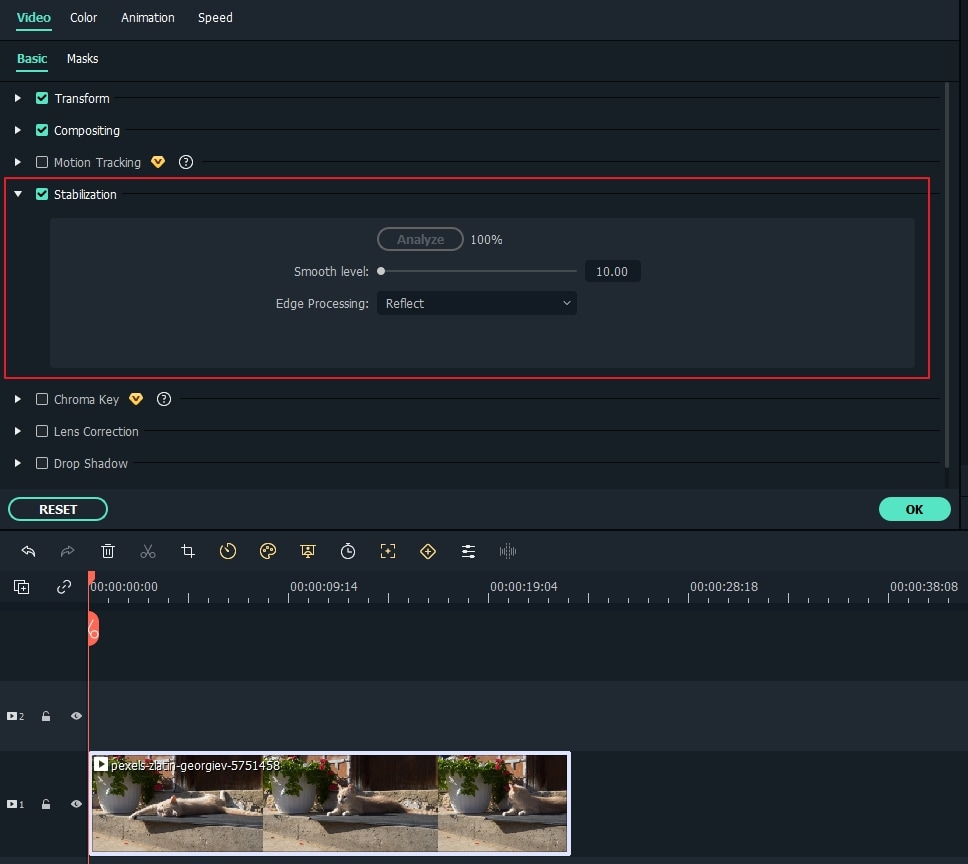
A video editing panel will open at the top left corner, and Filmora will analyze it automatically. You can also adjust the Smooth Level to get the best result.

You can check our stabilized Video guide for more detailed information about video stabilization.
Step 2: Improve video quality
After uploading your media file to the program, drag and drop it to the timeline, and double-click the media file in the timeline to open the video editing panel. Click the Color tab. Here you can adjust white balance, tone, and 3D LUT. And for Audio, click Audio, and then you can adjust output volume, fade in, fade out and pitch.
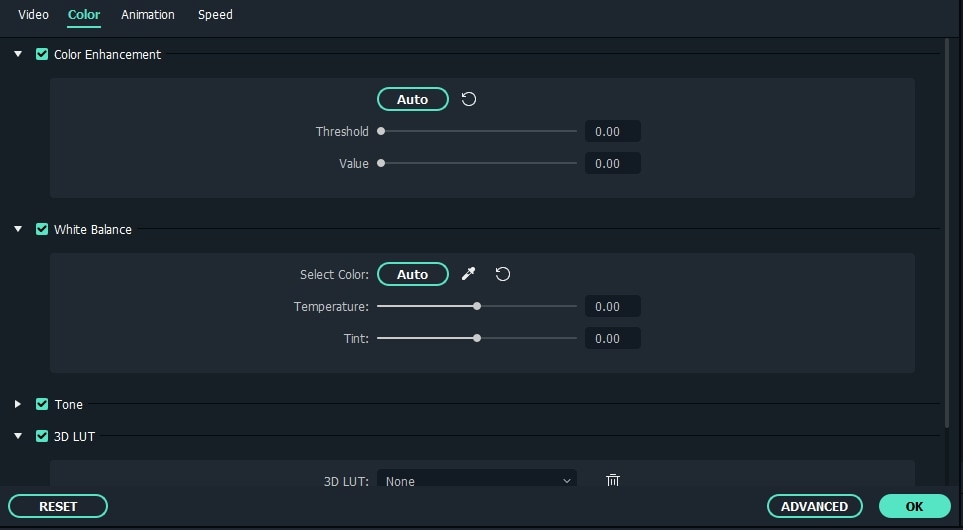
To enhance the color in the video, you can quickly change the color contrast, saturation, and brightness tint. You can also click the Advanced button to apply more color adjustments, such as white balance, Light including highlights, shadows, whites and blacks, HSL parameters and Vignette effects, and 3D LUT.

To improve the Audio quality in Video, you can remove the background noise in the Video. Switch to the Audio tab, and then click Remove background noise.

Filmora also features an Audio Mixer and Audio Equalizer (EQ) for you to improve the audio sound. For more audio editing features, you can check our audio editing guide .
Step 3: Add transitions, filters, and overlays to enhance video quality
If you want to have wonderful effects on your video, you can apply different filters, overlays, and transitions. There are more than 300 video effects built-in in Filmora and many more in Filmora Effect Store.
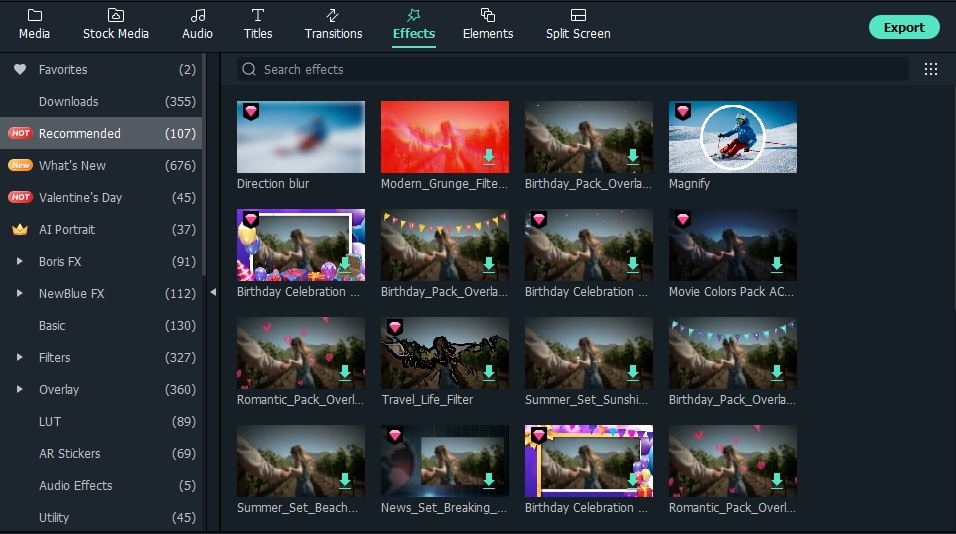
Step 4: Save or share your video
Afterward, you need to save it by clicking on the Export button and choosing the location where you want it to be saved. You can save your video in various formats - but also share it directly on YouTube, Vimeo, and other popular mediums. This saves your time and effort and integrates all the processes thoroughly.
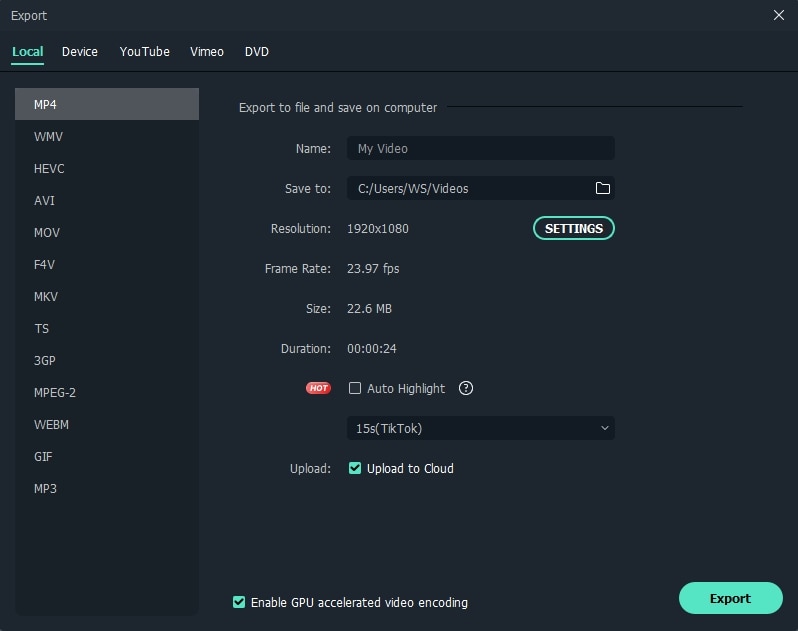
With Wondershare Filmora, you can add eye-catching filters, elements, transitions, and text fields to your videos. You can enhance the quality of your video and make it worthwhile watching.
Wondershare Filmora lets you enjoy some of the most advanced editing tools. The program is packed with features and can transform your video in a great way, with tools like rotation, cropping, and cutting. Wondershare Filmora can also let you use filters for your videos or add transitions and intros to them. Learn more from Wondershare Video Community .
2.Windows Movie Maker: built-in video enhancer for Windows 7 users
Price: Free
Compatibility: Windows 7, 8 & 10
We know that Windows Movie Maker has stopped updating , but many still use it to enhance video quality. The standard Movie Maker by Windows has been our go-to app for filming videos. Windows Movie Maker lets you not only enhance but also come up with new videos and directly publish them on YouTube.
Simply put, the Windows Movie Maker lets you import your video and edit it easily. There are also various effects and transitions that can help you switch through scenes. Also, you can add animated titles with texts and make your videos even more catcher. Undoubtedly, the Windows Movie Maker is one of the standard best-quality video enhancers in the market.

3.iMovie: Built-in Video Enhancer for Mac Users
Price: Free
Compatibility: macOS, iOS
Instead of spending hundreds of dollars on professional video editing software, Mac owners can try editing their videos in iMovie . The best part is that the software can be used on iPhones and iPads, as well as on Apple’s computers, so you can edit your footage immediately after you capture it.
iMovie supports 4K videos, making the editing process fun and easy. You have to arrange your clips on the timeline, select the background music, create opening titles and end credits or add some cool visual effects and you’re ready to share your videos with the public. iMovie lets you share your 4k videos to YouTube, Facebook, or Vimeo directly from the Export menu, so you don’t have to waste time waiting for your videos to be rendered and uploaded to your social media account.
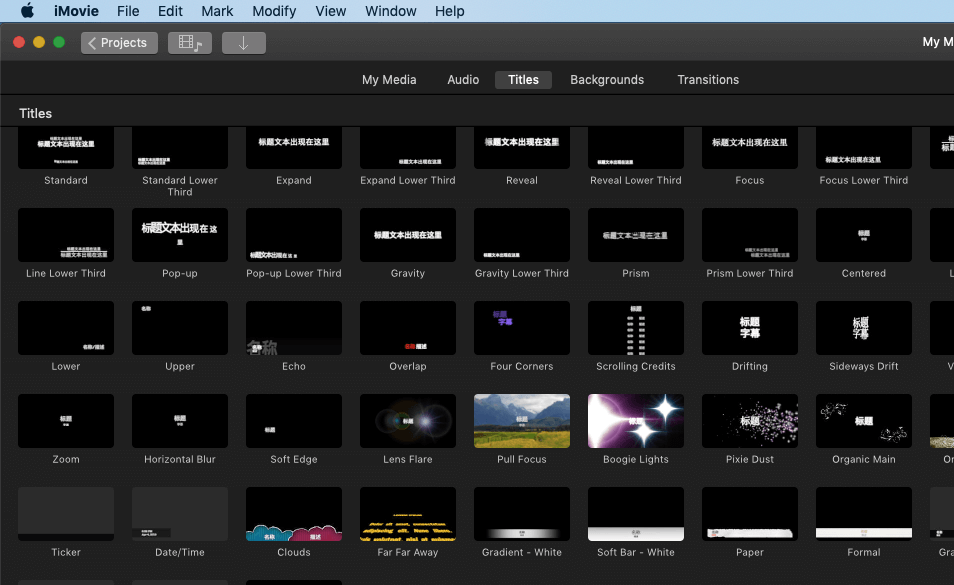
4.Avidemux
Price: Free
Compatibility: Windows, MacOS, and Linux
Avidemux is a free, open-source video editing program with a clear interface, so enhancing video quality is easy with Avidemux.
The best thing about Avidemux when it comes to the top video quality enhancers is that it supports a lot of file formats. From FLV to MKV, AVI, WMV, MOV, OGM, MPEG, and MP4, Avidemux lets you enhance the quality of any file format easily. The multithreading option is also a great feature - and possibly the program’s finest advantage.
However, there is no timeline, creative effects, or transitions to enhance the video.

5.Adobe Premiere Pro CC
Price: Monthly license: $35.99
Compatibility: Windows, macOS
Over the last couple of decades, the Adobe brand has become synonymous with image editing. The company’s software for editing still and moving images is considered among the best by most contemporary photographers, designers, and moviemakers.
Premiere Pro CC enables you to turn the raw footage captured by any camera in any format into awe-inspiring videos. Besides offering superb video editing options that include powerful color correction tools and amazing effects, the software also offers a decent amount of audio editing options.
The only downside is that Premiere Pro CC is not best suited for inexperienced video editors, and it takes quite some time to master all of its features.
6.Vegas Pro
Price:$399.00
Compatibility: Windows
Although Vegas Pro has never been as popular as Premier Pro, the video editing options, Vega Pro offers are no less powerful than those provided by Adobe’s famed video enhancer. Vegas Pro software is equipped with tools that make the video editing process faster while maintaining a high quality of the processed footage.
The latest version of Vegas Pro also features Picture-in-Picture and Crop OFX plug-ins that let you overlay or experiment with several images in a single frame.
The Blue FX’s Filter 5 Ultimate package contains 26 effects that enable you to use colors in your videos or change the light, so each video you produce with Vegas Pro can have the visual style you want.
7.Lightworks
Price: free, monthly license $23.99
Compatibility: Windows, Linux, macOS
Quentin Tarantino, Martin Scorsese, and Danny Boyle are just a few world-famous movie directors whose movies were edited in Lightworks. What’s more, in 2017, the software won the Emmy Award for pioneering digital non-linear editing. Lightworks has been one of the industry’s best video enhancers for nearly thirty years, offering groundbreaking features to cinema professionals adore.
This video editing software lets you do virtually anything if you know how to do it. Multicam editing, a rich selection of effects, or support for a wide array of video file formats make Lightworks an excellent choice for skilled video editing professionals.
Even though the free version of the software is available, buying a monthly or annual license is a much better option if you want to approach your next project professionally.
8.Final Cut Pro X
Price: $249.99
Compatibility: macOS
The possibilities Final Cut Pro offers are nearly endless. The software supports almost all video file formats, its non-linear timeline lets you arrange all sorts of media files freely, and the color wheels allow you to enhance the colors in your videos by simply dragging the mouse cursor. Besides providing support for 360-degree videos, Final Cut Pro also offers 360-degree graphics and effects.
The video editor is built on a 64-bit, enabling users to work on highly demanding projects. However, it is best to check the system requirements before installing it on your Mac computer. Final Cut Pro is unsuitable for beginners in video editing because using most of its features requires an enviable amount of skill.
Conclusion
Now you know how to improve your video quality and which quality enhancer software suits you.
Choosing a video editing software that best serves your needs is never easy because there are so many different options available in the market.
Yet, if you are not ready to start working on your video editing skills, so for no reason to spend a lot of money on software like Final Cut Pro, Adobe Premiere Pro, or Lightworks. You can use a free video editor like iMovie or Windows Movie Maker, but you get what you pay. You won’t have to spend a lot of money on Filmora. Still, you will be able to produce impressive videos.
Videographers and video editors who take the movie-making process more seriously can only benefit from using high-end video editing software products because they open up endless creative possibilities.
Leave a comment below and let us know which video editing software you use to enhance your videos.
FAQ:
- Which is better: Windows Movie Maker or iMovie?
Reviewers looked at both options and found that Windows Movie Maker was easier to use. However, iMovie is easier to set up and use. Overall, people who reviewed iMovie said they liked working with it. Reviewers thought that iMovie was better for their business needs than Windows Movie Maker.
- Is using iMovie on Windows a smart idea?
Can I use iMovie on a Windows computer? It can only be used on iOS and macOS. On a Windows PC, you can run some alternatives. For Windows, MiniTool Movie Maker is a fantastic video editor. With it, it’s simple to edit video, split or trim it, add animated text, and carry out other operations.
- Comparison between Final Cut Pro and iMovie.
Since its files are smaller and have fewer tools, iMovie works faster than Final Cut Pro. Final Cut Pro has a wide range of cutting-edge features because it was made mostly for professional editors. On the other hand, iMovie has fewer features and editing tools for people who are just starting.
- Is Final Cut Pro challenging to learn?
You might find the interface of Final Cut Pro a little intimidating if you’ve used other video editing programs like iMovie. Don’t worry. Learning the basic editing skills, you’ll use for 90% of your work with Final Cut Pro takes a few minutes.

Liza Brown
Liza Brown is a writer and a lover of all things video.
Follow @Liza Brown
Liza Brown
Mar 27, 2024• Proven solutions
Nowadays experience of watching and sharing a video with high resolution plays a great role. But what happens when the video resolution is poor? Or is the video too dark or shaky? Or is there some background audio noise recorded in the video?
All in all, how to improve video quality in such cases? It’s simple - we use the video quality enhancers available online for free and paid.
There is so much video enhancement software available on the market. At the same time, in this article, we have picked up the best video enhancers [free and paid] **for Windows and Mac, which are powerful enough to enhance your clips. And also guide you step by step on how to enhance video quality.
Best Free & Paid Video Enhancer Software to Improve Quality
1. Wondershare Filmora : The best video enhancer for beginners and semi-pros [Windows & Mac]
For Win 7 or later (64-bit)
 Secure Download
Secure Download
For macOS 10.12 or later
 Secure Download
Secure Download
Price: Free/Paid
Compatibility: Windows, macOS
Wondershare Filmora is the world’s finest video editor in the market and deserves the number 1 place on our list.
Filmora is available on both Windows and macOS; the screenshots below are from the Windows version. Besides, the exported video on Windows also can be used on Mac.
In this video editor, you will find professional tools that help you improve the video quality and more than 300 creative filters and effects to make your video with a new fresh look to improve video quality without much effort. Besides the features that let you change video rotation easily, this video enhancer is one of the most reliable currently in the marketplace.
Filmora can enhance video quality with at least the following 4 aspects:
- Automatic video quality enhancement by stabilizing shaky videos.
- One-click background noise removal for improving video audio quality.
- Professional video color enhancement.
- Special video filters, transitions, and effects.
How to enhance the video qualitywith Wondershare Filmora
Step 1: Import video files
Open the program and hit the button ‘Import’ to load the local files to the media library. You can also drag and drop your files into the program. Whether it’s a video, audio, or a picture, Wondershare Filmora can improve its quality.

To improve the video quality by removing the shakiness in the video clip, right-click on the video clip in the timeline and select Stabilization.

A video editing panel will open at the top left corner, and Filmora will analyze it automatically. You can also adjust the Smooth Level to get the best result.

You can check our stabilized Video guide for more detailed information about video stabilization.
Step 2: Improve video quality
After uploading your media file to the program, drag and drop it to the timeline, and double-click the media file in the timeline to open the video editing panel. Click the Color tab. Here you can adjust white balance, tone, and 3D LUT. And for Audio, click Audio, and then you can adjust output volume, fade in, fade out and pitch.

To enhance the color in the video, you can quickly change the color contrast, saturation, and brightness tint. You can also click the Advanced button to apply more color adjustments, such as white balance, Light including highlights, shadows, whites and blacks, HSL parameters and Vignette effects, and 3D LUT.

To improve the Audio quality in Video, you can remove the background noise in the Video. Switch to the Audio tab, and then click Remove background noise.

Filmora also features an Audio Mixer and Audio Equalizer (EQ) for you to improve the audio sound. For more audio editing features, you can check our audio editing guide .
Step 3: Add transitions, filters, and overlays to enhance video quality
If you want to have wonderful effects on your video, you can apply different filters, overlays, and transitions. There are more than 300 video effects built-in in Filmora and many more in Filmora Effect Store.

Step 4: Save or share your video
Afterward, you need to save it by clicking on the Export button and choosing the location where you want it to be saved. You can save your video in various formats - but also share it directly on YouTube, Vimeo, and other popular mediums. This saves your time and effort and integrates all the processes thoroughly.

With Wondershare Filmora, you can add eye-catching filters, elements, transitions, and text fields to your videos. You can enhance the quality of your video and make it worthwhile watching.
Wondershare Filmora lets you enjoy some of the most advanced editing tools. The program is packed with features and can transform your video in a great way, with tools like rotation, cropping, and cutting. Wondershare Filmora can also let you use filters for your videos or add transitions and intros to them. Learn more from Wondershare Video Community .
2.Windows Movie Maker: built-in video enhancer for Windows 7 users
Price: Free
Compatibility: Windows 7, 8 & 10
We know that Windows Movie Maker has stopped updating , but many still use it to enhance video quality. The standard Movie Maker by Windows has been our go-to app for filming videos. Windows Movie Maker lets you not only enhance but also come up with new videos and directly publish them on YouTube.
Simply put, the Windows Movie Maker lets you import your video and edit it easily. There are also various effects and transitions that can help you switch through scenes. Also, you can add animated titles with texts and make your videos even more catcher. Undoubtedly, the Windows Movie Maker is one of the standard best-quality video enhancers in the market.

3.iMovie: Built-in Video Enhancer for Mac Users
Price: Free
Compatibility: macOS, iOS
Instead of spending hundreds of dollars on professional video editing software, Mac owners can try editing their videos in iMovie . The best part is that the software can be used on iPhones and iPads, as well as on Apple’s computers, so you can edit your footage immediately after you capture it.
iMovie supports 4K videos, making the editing process fun and easy. You have to arrange your clips on the timeline, select the background music, create opening titles and end credits or add some cool visual effects and you’re ready to share your videos with the public. iMovie lets you share your 4k videos to YouTube, Facebook, or Vimeo directly from the Export menu, so you don’t have to waste time waiting for your videos to be rendered and uploaded to your social media account.

4.Avidemux
Price: Free
Compatibility: Windows, MacOS, and Linux
Avidemux is a free, open-source video editing program with a clear interface, so enhancing video quality is easy with Avidemux.
The best thing about Avidemux when it comes to the top video quality enhancers is that it supports a lot of file formats. From FLV to MKV, AVI, WMV, MOV, OGM, MPEG, and MP4, Avidemux lets you enhance the quality of any file format easily. The multithreading option is also a great feature - and possibly the program’s finest advantage.
However, there is no timeline, creative effects, or transitions to enhance the video.

5.Adobe Premiere Pro CC
Price: Monthly license: $35.99
Compatibility: Windows, macOS
Over the last couple of decades, the Adobe brand has become synonymous with image editing. The company’s software for editing still and moving images is considered among the best by most contemporary photographers, designers, and moviemakers.
Premiere Pro CC enables you to turn the raw footage captured by any camera in any format into awe-inspiring videos. Besides offering superb video editing options that include powerful color correction tools and amazing effects, the software also offers a decent amount of audio editing options.
The only downside is that Premiere Pro CC is not best suited for inexperienced video editors, and it takes quite some time to master all of its features.
6.Vegas Pro
Price:$399.00
Compatibility: Windows
Although Vegas Pro has never been as popular as Premier Pro, the video editing options, Vega Pro offers are no less powerful than those provided by Adobe’s famed video enhancer. Vegas Pro software is equipped with tools that make the video editing process faster while maintaining a high quality of the processed footage.
The latest version of Vegas Pro also features Picture-in-Picture and Crop OFX plug-ins that let you overlay or experiment with several images in a single frame.
The Blue FX’s Filter 5 Ultimate package contains 26 effects that enable you to use colors in your videos or change the light, so each video you produce with Vegas Pro can have the visual style you want.
7.Lightworks
Price: free, monthly license $23.99
Compatibility: Windows, Linux, macOS
Quentin Tarantino, Martin Scorsese, and Danny Boyle are just a few world-famous movie directors whose movies were edited in Lightworks. What’s more, in 2017, the software won the Emmy Award for pioneering digital non-linear editing. Lightworks has been one of the industry’s best video enhancers for nearly thirty years, offering groundbreaking features to cinema professionals adore.
This video editing software lets you do virtually anything if you know how to do it. Multicam editing, a rich selection of effects, or support for a wide array of video file formats make Lightworks an excellent choice for skilled video editing professionals.
Even though the free version of the software is available, buying a monthly or annual license is a much better option if you want to approach your next project professionally.
8.Final Cut Pro X
Price: $249.99
Compatibility: macOS
The possibilities Final Cut Pro offers are nearly endless. The software supports almost all video file formats, its non-linear timeline lets you arrange all sorts of media files freely, and the color wheels allow you to enhance the colors in your videos by simply dragging the mouse cursor. Besides providing support for 360-degree videos, Final Cut Pro also offers 360-degree graphics and effects.
The video editor is built on a 64-bit, enabling users to work on highly demanding projects. However, it is best to check the system requirements before installing it on your Mac computer. Final Cut Pro is unsuitable for beginners in video editing because using most of its features requires an enviable amount of skill.
Conclusion
Now you know how to improve your video quality and which quality enhancer software suits you.
Choosing a video editing software that best serves your needs is never easy because there are so many different options available in the market.
Yet, if you are not ready to start working on your video editing skills, so for no reason to spend a lot of money on software like Final Cut Pro, Adobe Premiere Pro, or Lightworks. You can use a free video editor like iMovie or Windows Movie Maker, but you get what you pay. You won’t have to spend a lot of money on Filmora. Still, you will be able to produce impressive videos.
Videographers and video editors who take the movie-making process more seriously can only benefit from using high-end video editing software products because they open up endless creative possibilities.
Leave a comment below and let us know which video editing software you use to enhance your videos.
FAQ:
- Which is better: Windows Movie Maker or iMovie?
Reviewers looked at both options and found that Windows Movie Maker was easier to use. However, iMovie is easier to set up and use. Overall, people who reviewed iMovie said they liked working with it. Reviewers thought that iMovie was better for their business needs than Windows Movie Maker.
- Is using iMovie on Windows a smart idea?
Can I use iMovie on a Windows computer? It can only be used on iOS and macOS. On a Windows PC, you can run some alternatives. For Windows, MiniTool Movie Maker is a fantastic video editor. With it, it’s simple to edit video, split or trim it, add animated text, and carry out other operations.
- Comparison between Final Cut Pro and iMovie.
Since its files are smaller and have fewer tools, iMovie works faster than Final Cut Pro. Final Cut Pro has a wide range of cutting-edge features because it was made mostly for professional editors. On the other hand, iMovie has fewer features and editing tools for people who are just starting.
- Is Final Cut Pro challenging to learn?
You might find the interface of Final Cut Pro a little intimidating if you’ve used other video editing programs like iMovie. Don’t worry. Learning the basic editing skills, you’ll use for 90% of your work with Final Cut Pro takes a few minutes.

Liza Brown
Liza Brown is a writer and a lover of all things video.
Follow @Liza Brown
Liza Brown
Mar 27, 2024• Proven solutions
Nowadays experience of watching and sharing a video with high resolution plays a great role. But what happens when the video resolution is poor? Or is the video too dark or shaky? Or is there some background audio noise recorded in the video?
All in all, how to improve video quality in such cases? It’s simple - we use the video quality enhancers available online for free and paid.
There is so much video enhancement software available on the market. At the same time, in this article, we have picked up the best video enhancers [free and paid] **for Windows and Mac, which are powerful enough to enhance your clips. And also guide you step by step on how to enhance video quality.
Best Free & Paid Video Enhancer Software to Improve Quality
1. Wondershare Filmora : The best video enhancer for beginners and semi-pros [Windows & Mac]
For Win 7 or later (64-bit)
 Secure Download
Secure Download
For macOS 10.12 or later
 Secure Download
Secure Download
Price: Free/Paid
Compatibility: Windows, macOS
Wondershare Filmora is the world’s finest video editor in the market and deserves the number 1 place on our list.
Filmora is available on both Windows and macOS; the screenshots below are from the Windows version. Besides, the exported video on Windows also can be used on Mac.
In this video editor, you will find professional tools that help you improve the video quality and more than 300 creative filters and effects to make your video with a new fresh look to improve video quality without much effort. Besides the features that let you change video rotation easily, this video enhancer is one of the most reliable currently in the marketplace.
Filmora can enhance video quality with at least the following 4 aspects:
- Automatic video quality enhancement by stabilizing shaky videos.
- One-click background noise removal for improving video audio quality.
- Professional video color enhancement.
- Special video filters, transitions, and effects.
How to enhance the video qualitywith Wondershare Filmora
Step 1: Import video files
Open the program and hit the button ‘Import’ to load the local files to the media library. You can also drag and drop your files into the program. Whether it’s a video, audio, or a picture, Wondershare Filmora can improve its quality.

To improve the video quality by removing the shakiness in the video clip, right-click on the video clip in the timeline and select Stabilization.

A video editing panel will open at the top left corner, and Filmora will analyze it automatically. You can also adjust the Smooth Level to get the best result.

You can check our stabilized Video guide for more detailed information about video stabilization.
Step 2: Improve video quality
After uploading your media file to the program, drag and drop it to the timeline, and double-click the media file in the timeline to open the video editing panel. Click the Color tab. Here you can adjust white balance, tone, and 3D LUT. And for Audio, click Audio, and then you can adjust output volume, fade in, fade out and pitch.

To enhance the color in the video, you can quickly change the color contrast, saturation, and brightness tint. You can also click the Advanced button to apply more color adjustments, such as white balance, Light including highlights, shadows, whites and blacks, HSL parameters and Vignette effects, and 3D LUT.

To improve the Audio quality in Video, you can remove the background noise in the Video. Switch to the Audio tab, and then click Remove background noise.

Filmora also features an Audio Mixer and Audio Equalizer (EQ) for you to improve the audio sound. For more audio editing features, you can check our audio editing guide .
Step 3: Add transitions, filters, and overlays to enhance video quality
If you want to have wonderful effects on your video, you can apply different filters, overlays, and transitions. There are more than 300 video effects built-in in Filmora and many more in Filmora Effect Store.

Step 4: Save or share your video
Afterward, you need to save it by clicking on the Export button and choosing the location where you want it to be saved. You can save your video in various formats - but also share it directly on YouTube, Vimeo, and other popular mediums. This saves your time and effort and integrates all the processes thoroughly.

With Wondershare Filmora, you can add eye-catching filters, elements, transitions, and text fields to your videos. You can enhance the quality of your video and make it worthwhile watching.
Wondershare Filmora lets you enjoy some of the most advanced editing tools. The program is packed with features and can transform your video in a great way, with tools like rotation, cropping, and cutting. Wondershare Filmora can also let you use filters for your videos or add transitions and intros to them. Learn more from Wondershare Video Community .
2.Windows Movie Maker: built-in video enhancer for Windows 7 users
Price: Free
Compatibility: Windows 7, 8 & 10
We know that Windows Movie Maker has stopped updating , but many still use it to enhance video quality. The standard Movie Maker by Windows has been our go-to app for filming videos. Windows Movie Maker lets you not only enhance but also come up with new videos and directly publish them on YouTube.
Simply put, the Windows Movie Maker lets you import your video and edit it easily. There are also various effects and transitions that can help you switch through scenes. Also, you can add animated titles with texts and make your videos even more catcher. Undoubtedly, the Windows Movie Maker is one of the standard best-quality video enhancers in the market.

3.iMovie: Built-in Video Enhancer for Mac Users
Price: Free
Compatibility: macOS, iOS
Instead of spending hundreds of dollars on professional video editing software, Mac owners can try editing their videos in iMovie . The best part is that the software can be used on iPhones and iPads, as well as on Apple’s computers, so you can edit your footage immediately after you capture it.
iMovie supports 4K videos, making the editing process fun and easy. You have to arrange your clips on the timeline, select the background music, create opening titles and end credits or add some cool visual effects and you’re ready to share your videos with the public. iMovie lets you share your 4k videos to YouTube, Facebook, or Vimeo directly from the Export menu, so you don’t have to waste time waiting for your videos to be rendered and uploaded to your social media account.

4.Avidemux
Price: Free
Compatibility: Windows, MacOS, and Linux
Avidemux is a free, open-source video editing program with a clear interface, so enhancing video quality is easy with Avidemux.
The best thing about Avidemux when it comes to the top video quality enhancers is that it supports a lot of file formats. From FLV to MKV, AVI, WMV, MOV, OGM, MPEG, and MP4, Avidemux lets you enhance the quality of any file format easily. The multithreading option is also a great feature - and possibly the program’s finest advantage.
However, there is no timeline, creative effects, or transitions to enhance the video.

5.Adobe Premiere Pro CC
Price: Monthly license: $35.99
Compatibility: Windows, macOS
Over the last couple of decades, the Adobe brand has become synonymous with image editing. The company’s software for editing still and moving images is considered among the best by most contemporary photographers, designers, and moviemakers.
Premiere Pro CC enables you to turn the raw footage captured by any camera in any format into awe-inspiring videos. Besides offering superb video editing options that include powerful color correction tools and amazing effects, the software also offers a decent amount of audio editing options.
The only downside is that Premiere Pro CC is not best suited for inexperienced video editors, and it takes quite some time to master all of its features.
6.Vegas Pro
Price:$399.00
Compatibility: Windows
Although Vegas Pro has never been as popular as Premier Pro, the video editing options, Vega Pro offers are no less powerful than those provided by Adobe’s famed video enhancer. Vegas Pro software is equipped with tools that make the video editing process faster while maintaining a high quality of the processed footage.
The latest version of Vegas Pro also features Picture-in-Picture and Crop OFX plug-ins that let you overlay or experiment with several images in a single frame.
The Blue FX’s Filter 5 Ultimate package contains 26 effects that enable you to use colors in your videos or change the light, so each video you produce with Vegas Pro can have the visual style you want.
7.Lightworks
Price: free, monthly license $23.99
Compatibility: Windows, Linux, macOS
Quentin Tarantino, Martin Scorsese, and Danny Boyle are just a few world-famous movie directors whose movies were edited in Lightworks. What’s more, in 2017, the software won the Emmy Award for pioneering digital non-linear editing. Lightworks has been one of the industry’s best video enhancers for nearly thirty years, offering groundbreaking features to cinema professionals adore.
This video editing software lets you do virtually anything if you know how to do it. Multicam editing, a rich selection of effects, or support for a wide array of video file formats make Lightworks an excellent choice for skilled video editing professionals.
Even though the free version of the software is available, buying a monthly or annual license is a much better option if you want to approach your next project professionally.
8.Final Cut Pro X
Price: $249.99
Compatibility: macOS
The possibilities Final Cut Pro offers are nearly endless. The software supports almost all video file formats, its non-linear timeline lets you arrange all sorts of media files freely, and the color wheels allow you to enhance the colors in your videos by simply dragging the mouse cursor. Besides providing support for 360-degree videos, Final Cut Pro also offers 360-degree graphics and effects.
The video editor is built on a 64-bit, enabling users to work on highly demanding projects. However, it is best to check the system requirements before installing it on your Mac computer. Final Cut Pro is unsuitable for beginners in video editing because using most of its features requires an enviable amount of skill.
Conclusion
Now you know how to improve your video quality and which quality enhancer software suits you.
Choosing a video editing software that best serves your needs is never easy because there are so many different options available in the market.
Yet, if you are not ready to start working on your video editing skills, so for no reason to spend a lot of money on software like Final Cut Pro, Adobe Premiere Pro, or Lightworks. You can use a free video editor like iMovie or Windows Movie Maker, but you get what you pay. You won’t have to spend a lot of money on Filmora. Still, you will be able to produce impressive videos.
Videographers and video editors who take the movie-making process more seriously can only benefit from using high-end video editing software products because they open up endless creative possibilities.
Leave a comment below and let us know which video editing software you use to enhance your videos.
FAQ:
- Which is better: Windows Movie Maker or iMovie?
Reviewers looked at both options and found that Windows Movie Maker was easier to use. However, iMovie is easier to set up and use. Overall, people who reviewed iMovie said they liked working with it. Reviewers thought that iMovie was better for their business needs than Windows Movie Maker.
- Is using iMovie on Windows a smart idea?
Can I use iMovie on a Windows computer? It can only be used on iOS and macOS. On a Windows PC, you can run some alternatives. For Windows, MiniTool Movie Maker is a fantastic video editor. With it, it’s simple to edit video, split or trim it, add animated text, and carry out other operations.
- Comparison between Final Cut Pro and iMovie.
Since its files are smaller and have fewer tools, iMovie works faster than Final Cut Pro. Final Cut Pro has a wide range of cutting-edge features because it was made mostly for professional editors. On the other hand, iMovie has fewer features and editing tools for people who are just starting.
- Is Final Cut Pro challenging to learn?
You might find the interface of Final Cut Pro a little intimidating if you’ve used other video editing programs like iMovie. Don’t worry. Learning the basic editing skills, you’ll use for 90% of your work with Final Cut Pro takes a few minutes.

Liza Brown
Liza Brown is a writer and a lover of all things video.
Follow @Liza Brown
Liza Brown
Mar 27, 2024• Proven solutions
Nowadays experience of watching and sharing a video with high resolution plays a great role. But what happens when the video resolution is poor? Or is the video too dark or shaky? Or is there some background audio noise recorded in the video?
All in all, how to improve video quality in such cases? It’s simple - we use the video quality enhancers available online for free and paid.
There is so much video enhancement software available on the market. At the same time, in this article, we have picked up the best video enhancers [free and paid] **for Windows and Mac, which are powerful enough to enhance your clips. And also guide you step by step on how to enhance video quality.
Best Free & Paid Video Enhancer Software to Improve Quality
1. Wondershare Filmora : The best video enhancer for beginners and semi-pros [Windows & Mac]
For Win 7 or later (64-bit)
 Secure Download
Secure Download
For macOS 10.12 or later
 Secure Download
Secure Download
Price: Free/Paid
Compatibility: Windows, macOS
Wondershare Filmora is the world’s finest video editor in the market and deserves the number 1 place on our list.
Filmora is available on both Windows and macOS; the screenshots below are from the Windows version. Besides, the exported video on Windows also can be used on Mac.
In this video editor, you will find professional tools that help you improve the video quality and more than 300 creative filters and effects to make your video with a new fresh look to improve video quality without much effort. Besides the features that let you change video rotation easily, this video enhancer is one of the most reliable currently in the marketplace.
Filmora can enhance video quality with at least the following 4 aspects:
- Automatic video quality enhancement by stabilizing shaky videos.
- One-click background noise removal for improving video audio quality.
- Professional video color enhancement.
- Special video filters, transitions, and effects.
How to enhance the video qualitywith Wondershare Filmora
Step 1: Import video files
Open the program and hit the button ‘Import’ to load the local files to the media library. You can also drag and drop your files into the program. Whether it’s a video, audio, or a picture, Wondershare Filmora can improve its quality.

To improve the video quality by removing the shakiness in the video clip, right-click on the video clip in the timeline and select Stabilization.

A video editing panel will open at the top left corner, and Filmora will analyze it automatically. You can also adjust the Smooth Level to get the best result.

You can check our stabilized Video guide for more detailed information about video stabilization.
Step 2: Improve video quality
After uploading your media file to the program, drag and drop it to the timeline, and double-click the media file in the timeline to open the video editing panel. Click the Color tab. Here you can adjust white balance, tone, and 3D LUT. And for Audio, click Audio, and then you can adjust output volume, fade in, fade out and pitch.

To enhance the color in the video, you can quickly change the color contrast, saturation, and brightness tint. You can also click the Advanced button to apply more color adjustments, such as white balance, Light including highlights, shadows, whites and blacks, HSL parameters and Vignette effects, and 3D LUT.

To improve the Audio quality in Video, you can remove the background noise in the Video. Switch to the Audio tab, and then click Remove background noise.

Filmora also features an Audio Mixer and Audio Equalizer (EQ) for you to improve the audio sound. For more audio editing features, you can check our audio editing guide .
Step 3: Add transitions, filters, and overlays to enhance video quality
If you want to have wonderful effects on your video, you can apply different filters, overlays, and transitions. There are more than 300 video effects built-in in Filmora and many more in Filmora Effect Store.

Step 4: Save or share your video
Afterward, you need to save it by clicking on the Export button and choosing the location where you want it to be saved. You can save your video in various formats - but also share it directly on YouTube, Vimeo, and other popular mediums. This saves your time and effort and integrates all the processes thoroughly.

With Wondershare Filmora, you can add eye-catching filters, elements, transitions, and text fields to your videos. You can enhance the quality of your video and make it worthwhile watching.
Wondershare Filmora lets you enjoy some of the most advanced editing tools. The program is packed with features and can transform your video in a great way, with tools like rotation, cropping, and cutting. Wondershare Filmora can also let you use filters for your videos or add transitions and intros to them. Learn more from Wondershare Video Community .
2.Windows Movie Maker: built-in video enhancer for Windows 7 users
Price: Free
Compatibility: Windows 7, 8 & 10
We know that Windows Movie Maker has stopped updating , but many still use it to enhance video quality. The standard Movie Maker by Windows has been our go-to app for filming videos. Windows Movie Maker lets you not only enhance but also come up with new videos and directly publish them on YouTube.
Simply put, the Windows Movie Maker lets you import your video and edit it easily. There are also various effects and transitions that can help you switch through scenes. Also, you can add animated titles with texts and make your videos even more catcher. Undoubtedly, the Windows Movie Maker is one of the standard best-quality video enhancers in the market.

3.iMovie: Built-in Video Enhancer for Mac Users
Price: Free
Compatibility: macOS, iOS
Instead of spending hundreds of dollars on professional video editing software, Mac owners can try editing their videos in iMovie . The best part is that the software can be used on iPhones and iPads, as well as on Apple’s computers, so you can edit your footage immediately after you capture it.
iMovie supports 4K videos, making the editing process fun and easy. You have to arrange your clips on the timeline, select the background music, create opening titles and end credits or add some cool visual effects and you’re ready to share your videos with the public. iMovie lets you share your 4k videos to YouTube, Facebook, or Vimeo directly from the Export menu, so you don’t have to waste time waiting for your videos to be rendered and uploaded to your social media account.

4.Avidemux
Price: Free
Compatibility: Windows, MacOS, and Linux
Avidemux is a free, open-source video editing program with a clear interface, so enhancing video quality is easy with Avidemux.
The best thing about Avidemux when it comes to the top video quality enhancers is that it supports a lot of file formats. From FLV to MKV, AVI, WMV, MOV, OGM, MPEG, and MP4, Avidemux lets you enhance the quality of any file format easily. The multithreading option is also a great feature - and possibly the program’s finest advantage.
However, there is no timeline, creative effects, or transitions to enhance the video.

5.Adobe Premiere Pro CC
Price: Monthly license: $35.99
Compatibility: Windows, macOS
Over the last couple of decades, the Adobe brand has become synonymous with image editing. The company’s software for editing still and moving images is considered among the best by most contemporary photographers, designers, and moviemakers.
Premiere Pro CC enables you to turn the raw footage captured by any camera in any format into awe-inspiring videos. Besides offering superb video editing options that include powerful color correction tools and amazing effects, the software also offers a decent amount of audio editing options.
The only downside is that Premiere Pro CC is not best suited for inexperienced video editors, and it takes quite some time to master all of its features.
6.Vegas Pro
Price:$399.00
Compatibility: Windows
Although Vegas Pro has never been as popular as Premier Pro, the video editing options, Vega Pro offers are no less powerful than those provided by Adobe’s famed video enhancer. Vegas Pro software is equipped with tools that make the video editing process faster while maintaining a high quality of the processed footage.
The latest version of Vegas Pro also features Picture-in-Picture and Crop OFX plug-ins that let you overlay or experiment with several images in a single frame.
The Blue FX’s Filter 5 Ultimate package contains 26 effects that enable you to use colors in your videos or change the light, so each video you produce with Vegas Pro can have the visual style you want.
7.Lightworks
Price: free, monthly license $23.99
Compatibility: Windows, Linux, macOS
Quentin Tarantino, Martin Scorsese, and Danny Boyle are just a few world-famous movie directors whose movies were edited in Lightworks. What’s more, in 2017, the software won the Emmy Award for pioneering digital non-linear editing. Lightworks has been one of the industry’s best video enhancers for nearly thirty years, offering groundbreaking features to cinema professionals adore.
This video editing software lets you do virtually anything if you know how to do it. Multicam editing, a rich selection of effects, or support for a wide array of video file formats make Lightworks an excellent choice for skilled video editing professionals.
Even though the free version of the software is available, buying a monthly or annual license is a much better option if you want to approach your next project professionally.
8.Final Cut Pro X
Price: $249.99
Compatibility: macOS
The possibilities Final Cut Pro offers are nearly endless. The software supports almost all video file formats, its non-linear timeline lets you arrange all sorts of media files freely, and the color wheels allow you to enhance the colors in your videos by simply dragging the mouse cursor. Besides providing support for 360-degree videos, Final Cut Pro also offers 360-degree graphics and effects.
The video editor is built on a 64-bit, enabling users to work on highly demanding projects. However, it is best to check the system requirements before installing it on your Mac computer. Final Cut Pro is unsuitable for beginners in video editing because using most of its features requires an enviable amount of skill.
Conclusion
Now you know how to improve your video quality and which quality enhancer software suits you.
Choosing a video editing software that best serves your needs is never easy because there are so many different options available in the market.
Yet, if you are not ready to start working on your video editing skills, so for no reason to spend a lot of money on software like Final Cut Pro, Adobe Premiere Pro, or Lightworks. You can use a free video editor like iMovie or Windows Movie Maker, but you get what you pay. You won’t have to spend a lot of money on Filmora. Still, you will be able to produce impressive videos.
Videographers and video editors who take the movie-making process more seriously can only benefit from using high-end video editing software products because they open up endless creative possibilities.
Leave a comment below and let us know which video editing software you use to enhance your videos.
FAQ:
- Which is better: Windows Movie Maker or iMovie?
Reviewers looked at both options and found that Windows Movie Maker was easier to use. However, iMovie is easier to set up and use. Overall, people who reviewed iMovie said they liked working with it. Reviewers thought that iMovie was better for their business needs than Windows Movie Maker.
- Is using iMovie on Windows a smart idea?
Can I use iMovie on a Windows computer? It can only be used on iOS and macOS. On a Windows PC, you can run some alternatives. For Windows, MiniTool Movie Maker is a fantastic video editor. With it, it’s simple to edit video, split or trim it, add animated text, and carry out other operations.
- Comparison between Final Cut Pro and iMovie.
Since its files are smaller and have fewer tools, iMovie works faster than Final Cut Pro. Final Cut Pro has a wide range of cutting-edge features because it was made mostly for professional editors. On the other hand, iMovie has fewer features and editing tools for people who are just starting.
- Is Final Cut Pro challenging to learn?
You might find the interface of Final Cut Pro a little intimidating if you’ve used other video editing programs like iMovie. Don’t worry. Learning the basic editing skills, you’ll use for 90% of your work with Final Cut Pro takes a few minutes.

Liza Brown
Liza Brown is a writer and a lover of all things video.
Follow @Liza Brown
The Science of Screen Resolutions: Calculating Pixel Ratios Like a Pro
How to Calculate Pixel Calculator Ratio
An easy yet powerful editor
Numerous effects to choose from
Detailed tutorials provided by the official channel
Size, formats, and resolution… What are pixels exactly doing with it?
![]()
So let’s review some basics on pixel calculator ratio to create an easy life, your workflow more productive, and your photos of the ideal size for the intended purpose.
In this article
01 [What is Pixel Aspect Ratio?](#Part 1)
02 [How is Pixel Ratio Calculated?](#Part 2)
03 [Par (pixel Aspect Ratio) in Adobe Premiere Pro/Filmora?](#Part 3)
04 [Difference among Pixel Aspect Ratio, Display Aspect Ratio, and Storage Aspect Ratio](#Part 4)
05 [How Aspect Ratios Affect UI/UX Design?](#Part 5)
Part 1 What is Pixel Aspect Ratio?
A digital image is not a single non-dividable thing. You’ll see that your photo is like a mosaic formed by small tiles if you zoom in far enough, which are known as pixels in photography.
The amount of these pixels and the way they are divided are the two elements that you’re required to take into account to know more about the resolution and pixel calculator ratio.
The Pixel Aspect Ratio is simply the latest way of defining the length of one side of a pixel in context to the length of the other.
Let’s say the ratio is 1:1; each side of the pixel is the same length as the other, also known as a square in pixels.
If the ratio is 2:1, it means that one side is twice the length of the other.
NOTE: The ‘Aspect Ratio’ does not define the actual or exact length of the side of a pixel is, just its “relative” size of one side to the other. The actual length will depend on how much you shrink or stretch a photo when recreating it. But if the Pixel Calculator Ratio is 1:1, then the pixels will always be square irrespective of the size of that particular photo.
![]()
Part 2 How is Pixel Ratio Calculated?
You can use a pixel ratio calculator to calculate the pixels within a screen. So, we’d like to suggest a calculator by xwebtools.com.
Here, you can see tabs, namely the Common Ratios Ratio Width, Ratio Height, Pixels Width, and Pixels Height.
![]()
How it works:
This pixel ratio calculator converts pixel dimensions to aspect ratios. It is an online free tool that assists you in calculating the aspect ratio value of an object or a photo.
The conversion can be carried in both ways, aspect ratio to pixels and pixels to aspect ratio. This screen resolution calculator offers a powerful and simple tool that can convert the ratio of images to pixels resolution and pixels to ratio dimensions.
You need to provide Pixels Width and Pixels Height to calculate the aspect ratio; the aspect ratio will be automatically calculated.
You need to provide Ratio Height and Ratio Width to calculate pixel resolutions. Both the Pixels Width and Height will get automatically calculated.
Part 3 What is Par (pixel Aspect Ratio) in Adobe Premiere Pro/Filmora?
Pixel ratio: Adobe Premiere Pro
As we already discussed, an aspect ratio defines width to height. The still picture and video frames have a frame aspect ratio. The pixels that create the frame have a pixel aspect ratio (sometimes called PAR).
Different video recording standards have different aspect ratios. For instance, you record video for television in either a 16:9 or a 4:3 frame aspect ratio.
You set the frame and pixel aspect when you create a project in Adobe Premiere Pro. Once you set these ratios, you can’t change them for that project. However, you can edit the aspect ratio of a sequence. You can also use assets made with different aspect ratios in the project.
Premiere Pro automatically compensates for the pixel aspect ratio of source files.
If an asset still feels distorted, you can manually mention its pixel aspect ratio. But that isn’t very clear, especially for a beginner. This is why we recommend doing the following.
Pixel ratio: Wondershare Filmora
You need a converter or a video editor to change the aspect ratio permanently. Here we humbly recommend an excellent aspect ratio changer - Wondershare Filmora video editor, which helps you make 4:3, 9:16, 16:9, and 1:1 aspect ratio videos pretty quickly.
Wondershare Filmora
Get started easily with Filmora’s powerful performance, intuitive interface, and countless effects!
Try It Free Try It Free Try It Free Learn More >

Furthermore, you can conveniently share these videos on YouTube, Apple TV, Vimeo, and mobile devices.
Transform aspect ratio at the beginning interface
Wondershare Filmora Video Editor helps you change the project aspect ratio right after launching the video editor program.
If you click the drop-down menu, you will see the usual 16:9, 1:1, 9:16, 4:3, and 21:9 aspect ratios.
![]()
Unlike Adobe Premiere Pro, Wondershare Filmora offers you four more ways of setting aspect ratios efficiently.
Method 2: You can change the aspect ratio under Project Settings
![]()
Method 3: Change the aspect ratio of video with Auto-Reframe
![]()
Method 4: Change aspect ratio during Editing
![]()
Method 5: Change aspect ratio while Exporting
![]()
Thus, using the Wondershare Filmora along with the pixel ratio calculator makes a difference!
Part 4 Difference among Pixel Aspect Ratio, Display Aspect Ratio, and Storage Aspect Ratio
Although the image aspect ratio comes from its width and height, it also contains multiple subsets that help to define image proportions properly.
1 - Pixel aspect ratio
Pixel aspect ratio (PAR) is the proportion of the specific pixels within an image. They are generally square within the pixel aspect ratio of 1:1.
But sometimes, specific images are optimized for certain types of displays. And, they have rectangular pixels with an aspect ratio of 4:3 or similar.
2 - Display aspect ratio
The display aspect ratio (DAR) is the designers’ most frequent aspect ratio and gets generally synced with the general term.
As the name suggests, the display aspect ratio refers to the proportions of an image as it appears on different screens out there.
Some devices, such as televisions and cameras, have a fixed DAR for images to display nicely on these devices.
They need optimization for their specific or respective aspect ratio. For instance, a typical display aspect ratio for the widescreen video on a television screen or monitor screen is 16:9.
They appear distorted when images with different aspect ratios are presented on these devices. Digital SLR camera sensors also consist of a fixed display aspect ratio, which controls how pictures captured by the camera will be displayed and saved.
3 - Storage aspect ratio
Storage aspect ratio, commonly known as (SAR) is an aspect ratio formula that concerns specifically to encoded digital video files. SAR refers to the height and the width relationship in video frame size, and it is required to be consistent among all individual frames.
SAR x PAR = DAR for max widescreen videos in a usual used formula.
Part 1 Part 5: How Aspect Ratios Affect UI/UX Design?
Aspect ratios play a vital part in any project that consists of displaying and capturing photographs, videos, or other image-based files in an ideal manner. The camera’s fixed aspect ratio can considerably impact, especially for photographers.
And for videographers or anyone working with slideshows, animations, and other motion projects, the aspect ratio is a prominent element for correct display on mobile devices and widescreen.
But even in the environment of responsive web design, problems can arise, such as when an image is not adjustable for display without compromising its quality or content.
A small example is when you need a square image with a 1:1 aspect ratio to insert into a rectangular box on a web page. To accommodate varying image size requirements, proportions and size may need adjustment.
In an increasingly picture-driven digital world, videos and images that look even slightly out of the way add to a visitor’s negative impression of a site. Besides those forced into the wrong configurations can even interfere with a site’s usability.
Poorly proportioned user guide or product images video that’s too stretched to check clearly can affect both a visitor’s want and their ability to use the site. Developers, designers, and anyone working with images will need to know how aspect ratios work and manipulate them for the best visual effect.
Various pixel calculator ratios, both paid and free, have popped up on the web to streamline the process.
Key Takeaways from This Episode
● An overview of pixels
● Understanding the importance of pixel ratio calculators
● Different pixel ratios and their impact on UI/UX design
Size, formats, and resolution… What are pixels exactly doing with it?
![]()
So let’s review some basics on pixel calculator ratio to create an easy life, your workflow more productive, and your photos of the ideal size for the intended purpose.
In this article
01 [What is Pixel Aspect Ratio?](#Part 1)
02 [How is Pixel Ratio Calculated?](#Part 2)
03 [Par (pixel Aspect Ratio) in Adobe Premiere Pro/Filmora?](#Part 3)
04 [Difference among Pixel Aspect Ratio, Display Aspect Ratio, and Storage Aspect Ratio](#Part 4)
05 [How Aspect Ratios Affect UI/UX Design?](#Part 5)
Part 1 What is Pixel Aspect Ratio?
A digital image is not a single non-dividable thing. You’ll see that your photo is like a mosaic formed by small tiles if you zoom in far enough, which are known as pixels in photography.
The amount of these pixels and the way they are divided are the two elements that you’re required to take into account to know more about the resolution and pixel calculator ratio.
The Pixel Aspect Ratio is simply the latest way of defining the length of one side of a pixel in context to the length of the other.
Let’s say the ratio is 1:1; each side of the pixel is the same length as the other, also known as a square in pixels.
If the ratio is 2:1, it means that one side is twice the length of the other.
NOTE: The ‘Aspect Ratio’ does not define the actual or exact length of the side of a pixel is, just its “relative” size of one side to the other. The actual length will depend on how much you shrink or stretch a photo when recreating it. But if the Pixel Calculator Ratio is 1:1, then the pixels will always be square irrespective of the size of that particular photo.
![]()
Part 2 How is Pixel Ratio Calculated?
You can use a pixel ratio calculator to calculate the pixels within a screen. So, we’d like to suggest a calculator by xwebtools.com.
Here, you can see tabs, namely the Common Ratios Ratio Width, Ratio Height, Pixels Width, and Pixels Height.
![]()
How it works:
This pixel ratio calculator converts pixel dimensions to aspect ratios. It is an online free tool that assists you in calculating the aspect ratio value of an object or a photo.
The conversion can be carried in both ways, aspect ratio to pixels and pixels to aspect ratio. This screen resolution calculator offers a powerful and simple tool that can convert the ratio of images to pixels resolution and pixels to ratio dimensions.
You need to provide Pixels Width and Pixels Height to calculate the aspect ratio; the aspect ratio will be automatically calculated.
You need to provide Ratio Height and Ratio Width to calculate pixel resolutions. Both the Pixels Width and Height will get automatically calculated.
Part 3 What is Par (pixel Aspect Ratio) in Adobe Premiere Pro/Filmora?
Pixel ratio: Adobe Premiere Pro
As we already discussed, an aspect ratio defines width to height. The still picture and video frames have a frame aspect ratio. The pixels that create the frame have a pixel aspect ratio (sometimes called PAR).
Different video recording standards have different aspect ratios. For instance, you record video for television in either a 16:9 or a 4:3 frame aspect ratio.
You set the frame and pixel aspect when you create a project in Adobe Premiere Pro. Once you set these ratios, you can’t change them for that project. However, you can edit the aspect ratio of a sequence. You can also use assets made with different aspect ratios in the project.
Premiere Pro automatically compensates for the pixel aspect ratio of source files.
If an asset still feels distorted, you can manually mention its pixel aspect ratio. But that isn’t very clear, especially for a beginner. This is why we recommend doing the following.
Pixel ratio: Wondershare Filmora
You need a converter or a video editor to change the aspect ratio permanently. Here we humbly recommend an excellent aspect ratio changer - Wondershare Filmora video editor, which helps you make 4:3, 9:16, 16:9, and 1:1 aspect ratio videos pretty quickly.
Wondershare Filmora
Get started easily with Filmora’s powerful performance, intuitive interface, and countless effects!
Try It Free Try It Free Try It Free Learn More >

Furthermore, you can conveniently share these videos on YouTube, Apple TV, Vimeo, and mobile devices.
Transform aspect ratio at the beginning interface
Wondershare Filmora Video Editor helps you change the project aspect ratio right after launching the video editor program.
If you click the drop-down menu, you will see the usual 16:9, 1:1, 9:16, 4:3, and 21:9 aspect ratios.
![]()
Unlike Adobe Premiere Pro, Wondershare Filmora offers you four more ways of setting aspect ratios efficiently.
Method 2: You can change the aspect ratio under Project Settings
![]()
Method 3: Change the aspect ratio of video with Auto-Reframe
![]()
Method 4: Change aspect ratio during Editing
![]()
Method 5: Change aspect ratio while Exporting
![]()
Thus, using the Wondershare Filmora along with the pixel ratio calculator makes a difference!
Part 4 Difference among Pixel Aspect Ratio, Display Aspect Ratio, and Storage Aspect Ratio
Although the image aspect ratio comes from its width and height, it also contains multiple subsets that help to define image proportions properly.
1 - Pixel aspect ratio
Pixel aspect ratio (PAR) is the proportion of the specific pixels within an image. They are generally square within the pixel aspect ratio of 1:1.
But sometimes, specific images are optimized for certain types of displays. And, they have rectangular pixels with an aspect ratio of 4:3 or similar.
2 - Display aspect ratio
The display aspect ratio (DAR) is the designers’ most frequent aspect ratio and gets generally synced with the general term.
As the name suggests, the display aspect ratio refers to the proportions of an image as it appears on different screens out there.
Some devices, such as televisions and cameras, have a fixed DAR for images to display nicely on these devices.
They need optimization for their specific or respective aspect ratio. For instance, a typical display aspect ratio for the widescreen video on a television screen or monitor screen is 16:9.
They appear distorted when images with different aspect ratios are presented on these devices. Digital SLR camera sensors also consist of a fixed display aspect ratio, which controls how pictures captured by the camera will be displayed and saved.
3 - Storage aspect ratio
Storage aspect ratio, commonly known as (SAR) is an aspect ratio formula that concerns specifically to encoded digital video files. SAR refers to the height and the width relationship in video frame size, and it is required to be consistent among all individual frames.
SAR x PAR = DAR for max widescreen videos in a usual used formula.
Part 1 Part 5: How Aspect Ratios Affect UI/UX Design?
Aspect ratios play a vital part in any project that consists of displaying and capturing photographs, videos, or other image-based files in an ideal manner. The camera’s fixed aspect ratio can considerably impact, especially for photographers.
And for videographers or anyone working with slideshows, animations, and other motion projects, the aspect ratio is a prominent element for correct display on mobile devices and widescreen.
But even in the environment of responsive web design, problems can arise, such as when an image is not adjustable for display without compromising its quality or content.
A small example is when you need a square image with a 1:1 aspect ratio to insert into a rectangular box on a web page. To accommodate varying image size requirements, proportions and size may need adjustment.
In an increasingly picture-driven digital world, videos and images that look even slightly out of the way add to a visitor’s negative impression of a site. Besides those forced into the wrong configurations can even interfere with a site’s usability.
Poorly proportioned user guide or product images video that’s too stretched to check clearly can affect both a visitor’s want and their ability to use the site. Developers, designers, and anyone working with images will need to know how aspect ratios work and manipulate them for the best visual effect.
Various pixel calculator ratios, both paid and free, have popped up on the web to streamline the process.
Key Takeaways from This Episode
● An overview of pixels
● Understanding the importance of pixel ratio calculators
● Different pixel ratios and their impact on UI/UX design
Size, formats, and resolution… What are pixels exactly doing with it?
![]()
So let’s review some basics on pixel calculator ratio to create an easy life, your workflow more productive, and your photos of the ideal size for the intended purpose.
In this article
01 [What is Pixel Aspect Ratio?](#Part 1)
02 [How is Pixel Ratio Calculated?](#Part 2)
03 [Par (pixel Aspect Ratio) in Adobe Premiere Pro/Filmora?](#Part 3)
04 [Difference among Pixel Aspect Ratio, Display Aspect Ratio, and Storage Aspect Ratio](#Part 4)
05 [How Aspect Ratios Affect UI/UX Design?](#Part 5)
Part 1 What is Pixel Aspect Ratio?
A digital image is not a single non-dividable thing. You’ll see that your photo is like a mosaic formed by small tiles if you zoom in far enough, which are known as pixels in photography.
The amount of these pixels and the way they are divided are the two elements that you’re required to take into account to know more about the resolution and pixel calculator ratio.
The Pixel Aspect Ratio is simply the latest way of defining the length of one side of a pixel in context to the length of the other.
Let’s say the ratio is 1:1; each side of the pixel is the same length as the other, also known as a square in pixels.
If the ratio is 2:1, it means that one side is twice the length of the other.
NOTE: The ‘Aspect Ratio’ does not define the actual or exact length of the side of a pixel is, just its “relative” size of one side to the other. The actual length will depend on how much you shrink or stretch a photo when recreating it. But if the Pixel Calculator Ratio is 1:1, then the pixels will always be square irrespective of the size of that particular photo.
![]()
Part 2 How is Pixel Ratio Calculated?
You can use a pixel ratio calculator to calculate the pixels within a screen. So, we’d like to suggest a calculator by xwebtools.com.
Here, you can see tabs, namely the Common Ratios Ratio Width, Ratio Height, Pixels Width, and Pixels Height.
![]()
How it works:
This pixel ratio calculator converts pixel dimensions to aspect ratios. It is an online free tool that assists you in calculating the aspect ratio value of an object or a photo.
The conversion can be carried in both ways, aspect ratio to pixels and pixels to aspect ratio. This screen resolution calculator offers a powerful and simple tool that can convert the ratio of images to pixels resolution and pixels to ratio dimensions.
You need to provide Pixels Width and Pixels Height to calculate the aspect ratio; the aspect ratio will be automatically calculated.
You need to provide Ratio Height and Ratio Width to calculate pixel resolutions. Both the Pixels Width and Height will get automatically calculated.
Part 3 What is Par (pixel Aspect Ratio) in Adobe Premiere Pro/Filmora?
Pixel ratio: Adobe Premiere Pro
As we already discussed, an aspect ratio defines width to height. The still picture and video frames have a frame aspect ratio. The pixels that create the frame have a pixel aspect ratio (sometimes called PAR).
Different video recording standards have different aspect ratios. For instance, you record video for television in either a 16:9 or a 4:3 frame aspect ratio.
You set the frame and pixel aspect when you create a project in Adobe Premiere Pro. Once you set these ratios, you can’t change them for that project. However, you can edit the aspect ratio of a sequence. You can also use assets made with different aspect ratios in the project.
Premiere Pro automatically compensates for the pixel aspect ratio of source files.
If an asset still feels distorted, you can manually mention its pixel aspect ratio. But that isn’t very clear, especially for a beginner. This is why we recommend doing the following.
Pixel ratio: Wondershare Filmora
You need a converter or a video editor to change the aspect ratio permanently. Here we humbly recommend an excellent aspect ratio changer - Wondershare Filmora video editor, which helps you make 4:3, 9:16, 16:9, and 1:1 aspect ratio videos pretty quickly.
Wondershare Filmora
Get started easily with Filmora’s powerful performance, intuitive interface, and countless effects!
Try It Free Try It Free Try It Free Learn More >

Furthermore, you can conveniently share these videos on YouTube, Apple TV, Vimeo, and mobile devices.
Transform aspect ratio at the beginning interface
Wondershare Filmora Video Editor helps you change the project aspect ratio right after launching the video editor program.
If you click the drop-down menu, you will see the usual 16:9, 1:1, 9:16, 4:3, and 21:9 aspect ratios.
![]()
Unlike Adobe Premiere Pro, Wondershare Filmora offers you four more ways of setting aspect ratios efficiently.
Method 2: You can change the aspect ratio under Project Settings
![]()
Method 3: Change the aspect ratio of video with Auto-Reframe
![]()
Method 4: Change aspect ratio during Editing
![]()
Method 5: Change aspect ratio while Exporting
![]()
Thus, using the Wondershare Filmora along with the pixel ratio calculator makes a difference!
Part 4 Difference among Pixel Aspect Ratio, Display Aspect Ratio, and Storage Aspect Ratio
Although the image aspect ratio comes from its width and height, it also contains multiple subsets that help to define image proportions properly.
1 - Pixel aspect ratio
Pixel aspect ratio (PAR) is the proportion of the specific pixels within an image. They are generally square within the pixel aspect ratio of 1:1.
But sometimes, specific images are optimized for certain types of displays. And, they have rectangular pixels with an aspect ratio of 4:3 or similar.
2 - Display aspect ratio
The display aspect ratio (DAR) is the designers’ most frequent aspect ratio and gets generally synced with the general term.
As the name suggests, the display aspect ratio refers to the proportions of an image as it appears on different screens out there.
Some devices, such as televisions and cameras, have a fixed DAR for images to display nicely on these devices.
They need optimization for their specific or respective aspect ratio. For instance, a typical display aspect ratio for the widescreen video on a television screen or monitor screen is 16:9.
They appear distorted when images with different aspect ratios are presented on these devices. Digital SLR camera sensors also consist of a fixed display aspect ratio, which controls how pictures captured by the camera will be displayed and saved.
3 - Storage aspect ratio
Storage aspect ratio, commonly known as (SAR) is an aspect ratio formula that concerns specifically to encoded digital video files. SAR refers to the height and the width relationship in video frame size, and it is required to be consistent among all individual frames.
SAR x PAR = DAR for max widescreen videos in a usual used formula.
Part 1 Part 5: How Aspect Ratios Affect UI/UX Design?
Aspect ratios play a vital part in any project that consists of displaying and capturing photographs, videos, or other image-based files in an ideal manner. The camera’s fixed aspect ratio can considerably impact, especially for photographers.
And for videographers or anyone working with slideshows, animations, and other motion projects, the aspect ratio is a prominent element for correct display on mobile devices and widescreen.
But even in the environment of responsive web design, problems can arise, such as when an image is not adjustable for display without compromising its quality or content.
A small example is when you need a square image with a 1:1 aspect ratio to insert into a rectangular box on a web page. To accommodate varying image size requirements, proportions and size may need adjustment.
In an increasingly picture-driven digital world, videos and images that look even slightly out of the way add to a visitor’s negative impression of a site. Besides those forced into the wrong configurations can even interfere with a site’s usability.
Poorly proportioned user guide or product images video that’s too stretched to check clearly can affect both a visitor’s want and their ability to use the site. Developers, designers, and anyone working with images will need to know how aspect ratios work and manipulate them for the best visual effect.
Various pixel calculator ratios, both paid and free, have popped up on the web to streamline the process.
Key Takeaways from This Episode
● An overview of pixels
● Understanding the importance of pixel ratio calculators
● Different pixel ratios and their impact on UI/UX design
Size, formats, and resolution… What are pixels exactly doing with it?
![]()
So let’s review some basics on pixel calculator ratio to create an easy life, your workflow more productive, and your photos of the ideal size for the intended purpose.
In this article
01 [What is Pixel Aspect Ratio?](#Part 1)
02 [How is Pixel Ratio Calculated?](#Part 2)
03 [Par (pixel Aspect Ratio) in Adobe Premiere Pro/Filmora?](#Part 3)
04 [Difference among Pixel Aspect Ratio, Display Aspect Ratio, and Storage Aspect Ratio](#Part 4)
05 [How Aspect Ratios Affect UI/UX Design?](#Part 5)
Part 1 What is Pixel Aspect Ratio?
A digital image is not a single non-dividable thing. You’ll see that your photo is like a mosaic formed by small tiles if you zoom in far enough, which are known as pixels in photography.
The amount of these pixels and the way they are divided are the two elements that you’re required to take into account to know more about the resolution and pixel calculator ratio.
The Pixel Aspect Ratio is simply the latest way of defining the length of one side of a pixel in context to the length of the other.
Let’s say the ratio is 1:1; each side of the pixel is the same length as the other, also known as a square in pixels.
If the ratio is 2:1, it means that one side is twice the length of the other.
NOTE: The ‘Aspect Ratio’ does not define the actual or exact length of the side of a pixel is, just its “relative” size of one side to the other. The actual length will depend on how much you shrink or stretch a photo when recreating it. But if the Pixel Calculator Ratio is 1:1, then the pixels will always be square irrespective of the size of that particular photo.
![]()
Part 2 How is Pixel Ratio Calculated?
You can use a pixel ratio calculator to calculate the pixels within a screen. So, we’d like to suggest a calculator by xwebtools.com.
Here, you can see tabs, namely the Common Ratios Ratio Width, Ratio Height, Pixels Width, and Pixels Height.
![]()
How it works:
This pixel ratio calculator converts pixel dimensions to aspect ratios. It is an online free tool that assists you in calculating the aspect ratio value of an object or a photo.
The conversion can be carried in both ways, aspect ratio to pixels and pixels to aspect ratio. This screen resolution calculator offers a powerful and simple tool that can convert the ratio of images to pixels resolution and pixels to ratio dimensions.
You need to provide Pixels Width and Pixels Height to calculate the aspect ratio; the aspect ratio will be automatically calculated.
You need to provide Ratio Height and Ratio Width to calculate pixel resolutions. Both the Pixels Width and Height will get automatically calculated.
Part 3 What is Par (pixel Aspect Ratio) in Adobe Premiere Pro/Filmora?
Pixel ratio: Adobe Premiere Pro
As we already discussed, an aspect ratio defines width to height. The still picture and video frames have a frame aspect ratio. The pixels that create the frame have a pixel aspect ratio (sometimes called PAR).
Different video recording standards have different aspect ratios. For instance, you record video for television in either a 16:9 or a 4:3 frame aspect ratio.
You set the frame and pixel aspect when you create a project in Adobe Premiere Pro. Once you set these ratios, you can’t change them for that project. However, you can edit the aspect ratio of a sequence. You can also use assets made with different aspect ratios in the project.
Premiere Pro automatically compensates for the pixel aspect ratio of source files.
If an asset still feels distorted, you can manually mention its pixel aspect ratio. But that isn’t very clear, especially for a beginner. This is why we recommend doing the following.
Pixel ratio: Wondershare Filmora
You need a converter or a video editor to change the aspect ratio permanently. Here we humbly recommend an excellent aspect ratio changer - Wondershare Filmora video editor, which helps you make 4:3, 9:16, 16:9, and 1:1 aspect ratio videos pretty quickly.
Wondershare Filmora
Get started easily with Filmora’s powerful performance, intuitive interface, and countless effects!
Try It Free Try It Free Try It Free Learn More >

Furthermore, you can conveniently share these videos on YouTube, Apple TV, Vimeo, and mobile devices.
Transform aspect ratio at the beginning interface
Wondershare Filmora Video Editor helps you change the project aspect ratio right after launching the video editor program.
If you click the drop-down menu, you will see the usual 16:9, 1:1, 9:16, 4:3, and 21:9 aspect ratios.
![]()
Unlike Adobe Premiere Pro, Wondershare Filmora offers you four more ways of setting aspect ratios efficiently.
Method 2: You can change the aspect ratio under Project Settings
![]()
Method 3: Change the aspect ratio of video with Auto-Reframe
![]()
Method 4: Change aspect ratio during Editing
![]()
Method 5: Change aspect ratio while Exporting
![]()
Thus, using the Wondershare Filmora along with the pixel ratio calculator makes a difference!
Part 4 Difference among Pixel Aspect Ratio, Display Aspect Ratio, and Storage Aspect Ratio
Although the image aspect ratio comes from its width and height, it also contains multiple subsets that help to define image proportions properly.
1 - Pixel aspect ratio
Pixel aspect ratio (PAR) is the proportion of the specific pixels within an image. They are generally square within the pixel aspect ratio of 1:1.
But sometimes, specific images are optimized for certain types of displays. And, they have rectangular pixels with an aspect ratio of 4:3 or similar.
2 - Display aspect ratio
The display aspect ratio (DAR) is the designers’ most frequent aspect ratio and gets generally synced with the general term.
As the name suggests, the display aspect ratio refers to the proportions of an image as it appears on different screens out there.
Some devices, such as televisions and cameras, have a fixed DAR for images to display nicely on these devices.
They need optimization for their specific or respective aspect ratio. For instance, a typical display aspect ratio for the widescreen video on a television screen or monitor screen is 16:9.
They appear distorted when images with different aspect ratios are presented on these devices. Digital SLR camera sensors also consist of a fixed display aspect ratio, which controls how pictures captured by the camera will be displayed and saved.
3 - Storage aspect ratio
Storage aspect ratio, commonly known as (SAR) is an aspect ratio formula that concerns specifically to encoded digital video files. SAR refers to the height and the width relationship in video frame size, and it is required to be consistent among all individual frames.
SAR x PAR = DAR for max widescreen videos in a usual used formula.
Part 1 Part 5: How Aspect Ratios Affect UI/UX Design?
Aspect ratios play a vital part in any project that consists of displaying and capturing photographs, videos, or other image-based files in an ideal manner. The camera’s fixed aspect ratio can considerably impact, especially for photographers.
And for videographers or anyone working with slideshows, animations, and other motion projects, the aspect ratio is a prominent element for correct display on mobile devices and widescreen.
But even in the environment of responsive web design, problems can arise, such as when an image is not adjustable for display without compromising its quality or content.
A small example is when you need a square image with a 1:1 aspect ratio to insert into a rectangular box on a web page. To accommodate varying image size requirements, proportions and size may need adjustment.
In an increasingly picture-driven digital world, videos and images that look even slightly out of the way add to a visitor’s negative impression of a site. Besides those forced into the wrong configurations can even interfere with a site’s usability.
Poorly proportioned user guide or product images video that’s too stretched to check clearly can affect both a visitor’s want and their ability to use the site. Developers, designers, and anyone working with images will need to know how aspect ratios work and manipulate them for the best visual effect.
Various pixel calculator ratios, both paid and free, have popped up on the web to streamline the process.
Key Takeaways from This Episode
● An overview of pixels
● Understanding the importance of pixel ratio calculators
● Different pixel ratios and their impact on UI/UX design
The Ultimate Avidemux Tutorial: How to Crop, Resize, and Enhance Your Videos
How to Crop a Video with Avidemux

Ollie Mattison
Mar 27, 2024• Proven solutions
Cropping a video, to bring focus onto the important aspects and remove the extraneous parts of the scene, is one of the most valuable tools available to a video editor. It can be used as mentioned to ensure the viewer focuses on what is important, but also to magnify objects on the screen, such as with footage of nature. It has many uses, and one of the best tools available for cropping video is the free program Avidemux. Here we are going to go through the process of getting Avidemux running on your system and cropping some video.
If Avidemux is too complicate for you, you can consider Wondershare Filmora , which is an easy-to-use video editing tool to crop videos within several click. Download the free trial version blow.
 Download Mac Version ](https://tools.techidaily.com/wondershare/filmora/download/ )
Download Mac Version ](https://tools.techidaily.com/wondershare/filmora/download/ )
How to Crop a Video with Avidemux
1. Installation
You can find Avidemux for download here , it is available for a wide range of platforms, just download the version that fits your needs. Once downloaded, install in the standard way for your platform, this is the Wndows version (64bit).
One point of note during installation is that you can choose which parts of the program you wish to install. It is a very small footprint and for the best performance it is wise to simply install everything.

Once installed you will be presented with the program as seen here.

2. Importing Video
The next step is importing video. This can be done in two ways, by clicking the file folder icon at the top left you open a standard file browser to navigate to, and select your chosen video file, or alternatively you can simply drag you video into the main panel to import it.

Whichever route you take, you will end up with your video file loaded in like this.

Now you can edit the video as you need, Avidemux contains a wealth of features to enable the full spectrum of editing tasks to be completed. However, here we are going to look at the cropping tool, so on to the next step.
3. Editing Video
Avidemux has some idiosyncrasies in terms of operation, one of those is that to be able to edit any video, you have to choose your output format. Don’t worry though, this is easy, just use the dropdown at the side to choose the output format you want as can be seen here.

Once that is set you are free to start editing your footage.
4. Cropping
It is important to understand how the editing process works in Avidemux, everything is accessed via the filters menu Video>Filters and from here you are faced with a new interface that enables you to choose the component you wish to use.

Selecting ‘Crop’ from the menu and pressing the green plus symbol at the bottom activated the crop tool and presents you with yet another view that allows you to adjust the crop to your tastes.

5. Cropping controls
There are two options for cropping, you can use the Auto crop feature, which will detect any black lines and crop the footage between them, or if you are using the crop tool for something else, or just want to do it manually, you can set the crop via the left right top and bottom boxes. Values input here are the number of pixels from that edge the crop extends, as you are setting it, this is displayed with a green block signifying the area of the image that will be removed.

You can adjust this independently for all 4 edges as you wish.
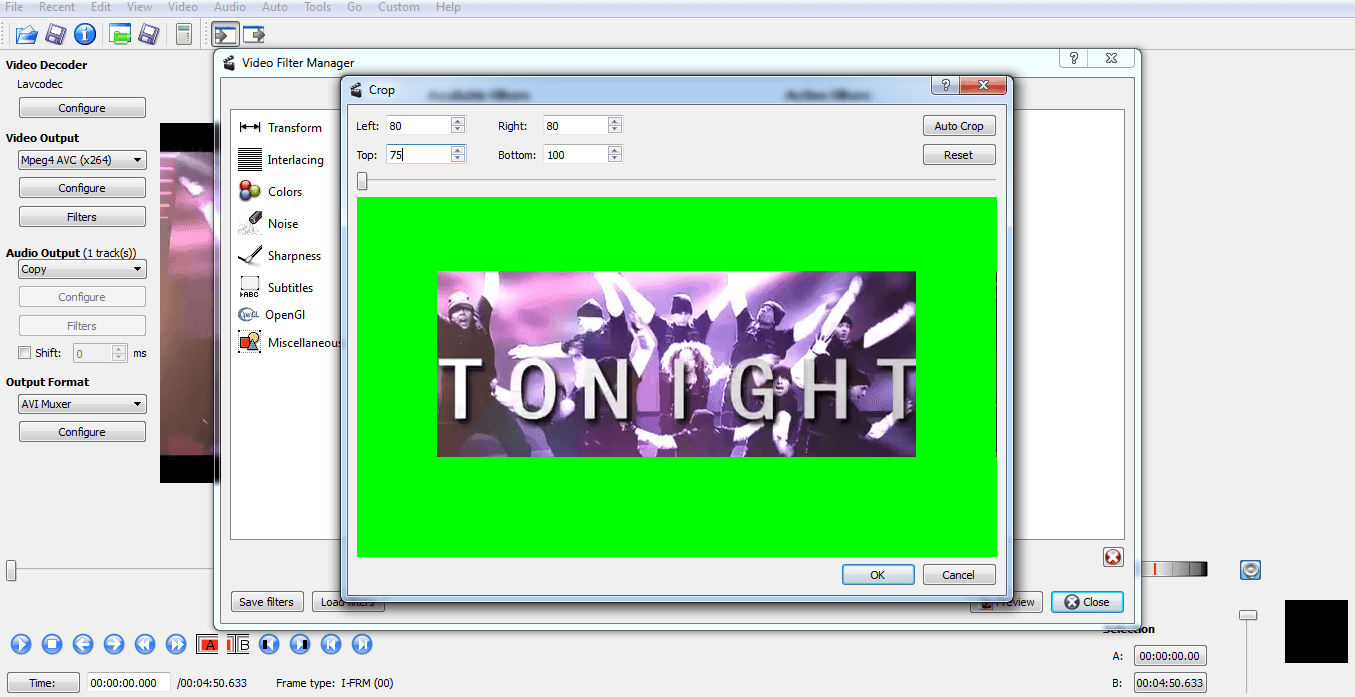
Once you are happy with the crop, you click Ok and it takes you back to the familiar filter menu where you can use other components to perform more editing if you need.
6. Saving the crop
One of the most common points of confusion with Avidemux comes at this point, as your video will look no different to when you started, and many think they have done something wrong, but this is another part of Avidemux workflow. These filters can only be applied when the video is reencoded, and you do that through the file>save menu.

Selecting this presents the familiar export dialogue and allows you to choose the name and destination of the file. Once that is done you click OK and you will see Avidemux processing your file and re-rendering it in this dialogue box.
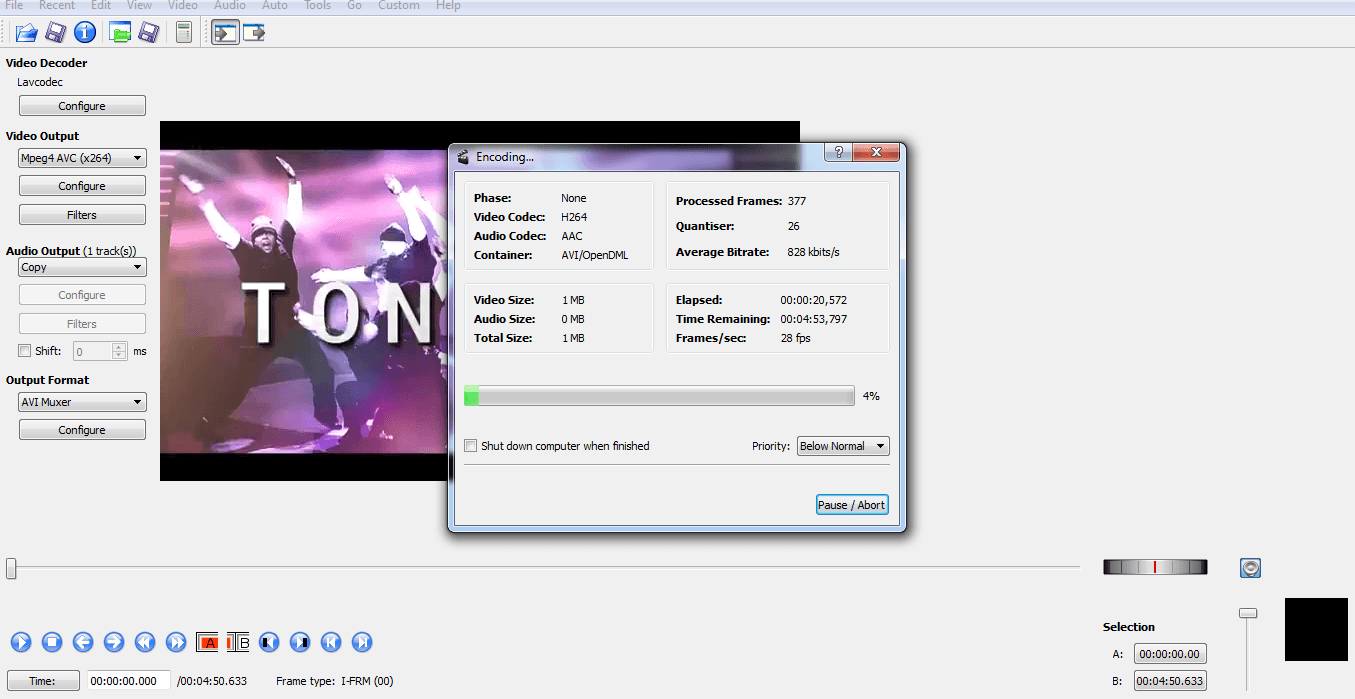
How long it takes will depend on a few factors, how many other effects have been added, how fast a processor your computer has, and how large and what resolution the video is. Format also plays a part in the process too, with some formats taking less time to encode than others. Once it has finished, you can view your video and see the crop in action.
As we can see, although there are a few aspects of the workflow that are a little unintuitive, cropping video in Avidemux is a straightforward process that anyone can accomplish with a bit of patience.
One of the key things to remember with Avidemux is that you apply all of your filters before re-encoding, this again is a question of patience and a bit of organization to ensure everything you wish to do is completed in order.
Avidemux is a great piece of software, it lacks the polish of some of its commercial rivals of course, but behind the sometimes clunky interface there is a very broad range of features that allow you to accomplish more or less any editing task you may want. In terms of free programs this is about as good as it gets, and the output is, without a doubt, great quality. For anyone looking for a free solution to video editing problems, and who do not mind a learning process Avidemux provides a useful tool.
An Easier Way to Crop a Video with Filmora
Filmora Video Editor is a powerful program that allows you to create stunning video clips in only a few clicks. This video editing software provides users with a variety of tools for editing videos. It also includes a user-friendly interface for editing home films on Windows PCs, Macs, and Linux devices. To crop a video, these are to follow:
Step 1: Open a video that you want to edit. Go to “Import” and choose the file that you want to upload and put it in the Media Library.
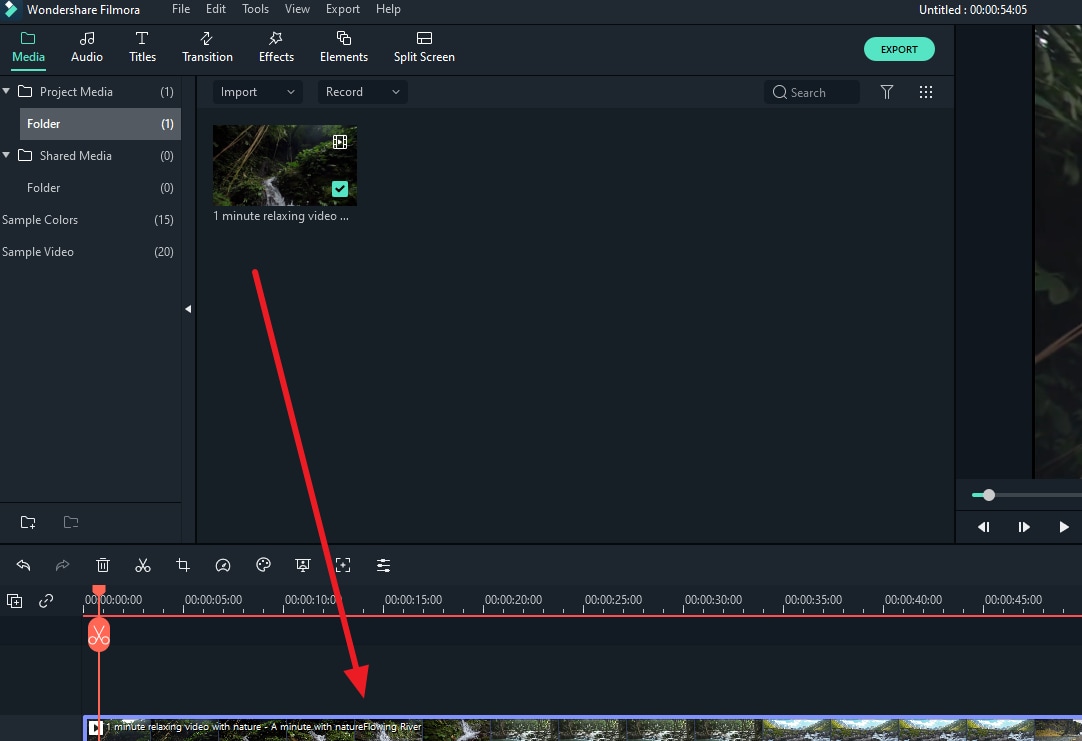
Step 2: Select the “Crop and Zoom” icon in the Filmora editing tool.
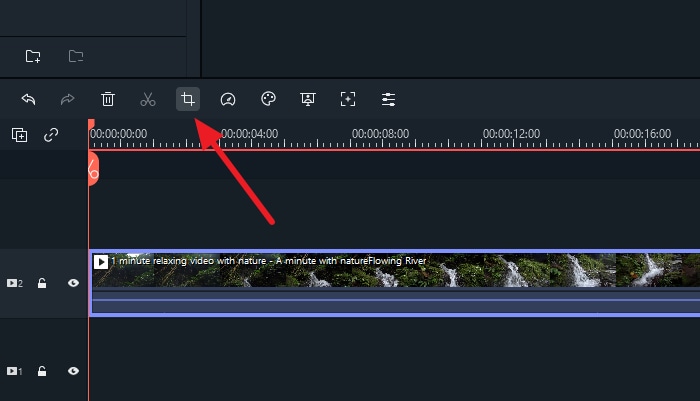
Step 3: To alter the size of the crop frame, drag the pointer from any corner of your video preview window.
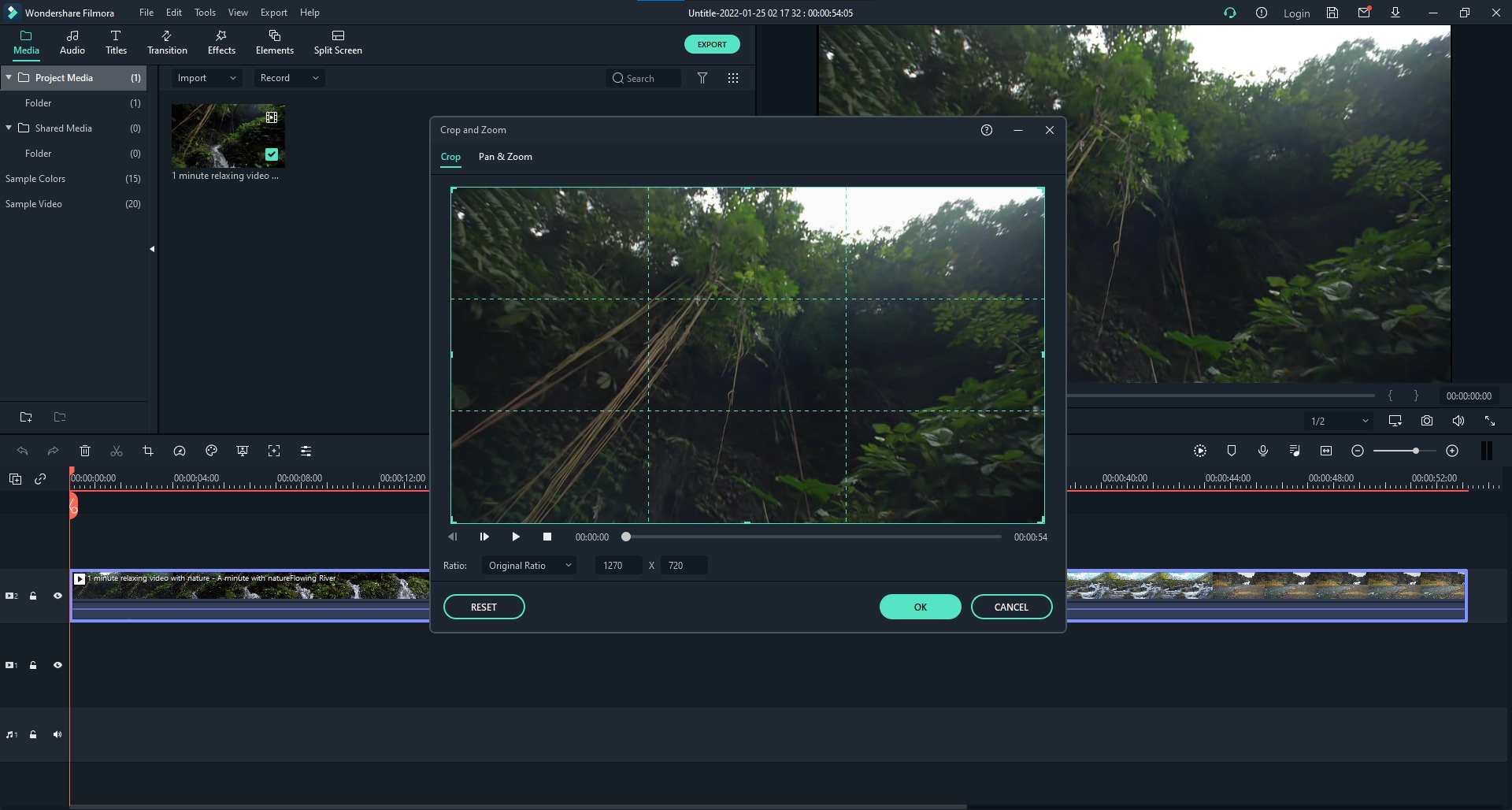
Step 4: When you’ve changed it to your liking, click the green “OK” button. As a result, you may effortlessly add or remove any element of a video clip on Filmora.


Ollie Mattison
Ollie Mattison is a writer and a lover of all things video.
Follow @Ollie Mattison
Ollie Mattison
Mar 27, 2024• Proven solutions
Cropping a video, to bring focus onto the important aspects and remove the extraneous parts of the scene, is one of the most valuable tools available to a video editor. It can be used as mentioned to ensure the viewer focuses on what is important, but also to magnify objects on the screen, such as with footage of nature. It has many uses, and one of the best tools available for cropping video is the free program Avidemux. Here we are going to go through the process of getting Avidemux running on your system and cropping some video.
If Avidemux is too complicate for you, you can consider Wondershare Filmora , which is an easy-to-use video editing tool to crop videos within several click. Download the free trial version blow.
 Download Mac Version ](https://tools.techidaily.com/wondershare/filmora/download/ )
Download Mac Version ](https://tools.techidaily.com/wondershare/filmora/download/ )
How to Crop a Video with Avidemux
1. Installation
You can find Avidemux for download here , it is available for a wide range of platforms, just download the version that fits your needs. Once downloaded, install in the standard way for your platform, this is the Wndows version (64bit).
One point of note during installation is that you can choose which parts of the program you wish to install. It is a very small footprint and for the best performance it is wise to simply install everything.

Once installed you will be presented with the program as seen here.

2. Importing Video
The next step is importing video. This can be done in two ways, by clicking the file folder icon at the top left you open a standard file browser to navigate to, and select your chosen video file, or alternatively you can simply drag you video into the main panel to import it.

Whichever route you take, you will end up with your video file loaded in like this.

Now you can edit the video as you need, Avidemux contains a wealth of features to enable the full spectrum of editing tasks to be completed. However, here we are going to look at the cropping tool, so on to the next step.
3. Editing Video
Avidemux has some idiosyncrasies in terms of operation, one of those is that to be able to edit any video, you have to choose your output format. Don’t worry though, this is easy, just use the dropdown at the side to choose the output format you want as can be seen here.

Once that is set you are free to start editing your footage.
4. Cropping
It is important to understand how the editing process works in Avidemux, everything is accessed via the filters menu Video>Filters and from here you are faced with a new interface that enables you to choose the component you wish to use.

Selecting ‘Crop’ from the menu and pressing the green plus symbol at the bottom activated the crop tool and presents you with yet another view that allows you to adjust the crop to your tastes.

5. Cropping controls
There are two options for cropping, you can use the Auto crop feature, which will detect any black lines and crop the footage between them, or if you are using the crop tool for something else, or just want to do it manually, you can set the crop via the left right top and bottom boxes. Values input here are the number of pixels from that edge the crop extends, as you are setting it, this is displayed with a green block signifying the area of the image that will be removed.

You can adjust this independently for all 4 edges as you wish.

Once you are happy with the crop, you click Ok and it takes you back to the familiar filter menu where you can use other components to perform more editing if you need.
6. Saving the crop
One of the most common points of confusion with Avidemux comes at this point, as your video will look no different to when you started, and many think they have done something wrong, but this is another part of Avidemux workflow. These filters can only be applied when the video is reencoded, and you do that through the file>save menu.

Selecting this presents the familiar export dialogue and allows you to choose the name and destination of the file. Once that is done you click OK and you will see Avidemux processing your file and re-rendering it in this dialogue box.

How long it takes will depend on a few factors, how many other effects have been added, how fast a processor your computer has, and how large and what resolution the video is. Format also plays a part in the process too, with some formats taking less time to encode than others. Once it has finished, you can view your video and see the crop in action.
As we can see, although there are a few aspects of the workflow that are a little unintuitive, cropping video in Avidemux is a straightforward process that anyone can accomplish with a bit of patience.
One of the key things to remember with Avidemux is that you apply all of your filters before re-encoding, this again is a question of patience and a bit of organization to ensure everything you wish to do is completed in order.
Avidemux is a great piece of software, it lacks the polish of some of its commercial rivals of course, but behind the sometimes clunky interface there is a very broad range of features that allow you to accomplish more or less any editing task you may want. In terms of free programs this is about as good as it gets, and the output is, without a doubt, great quality. For anyone looking for a free solution to video editing problems, and who do not mind a learning process Avidemux provides a useful tool.
An Easier Way to Crop a Video with Filmora
Filmora Video Editor is a powerful program that allows you to create stunning video clips in only a few clicks. This video editing software provides users with a variety of tools for editing videos. It also includes a user-friendly interface for editing home films on Windows PCs, Macs, and Linux devices. To crop a video, these are to follow:
Step 1: Open a video that you want to edit. Go to “Import” and choose the file that you want to upload and put it in the Media Library.

Step 2: Select the “Crop and Zoom” icon in the Filmora editing tool.

Step 3: To alter the size of the crop frame, drag the pointer from any corner of your video preview window.

Step 4: When you’ve changed it to your liking, click the green “OK” button. As a result, you may effortlessly add or remove any element of a video clip on Filmora.


Ollie Mattison
Ollie Mattison is a writer and a lover of all things video.
Follow @Ollie Mattison
Ollie Mattison
Mar 27, 2024• Proven solutions
Cropping a video, to bring focus onto the important aspects and remove the extraneous parts of the scene, is one of the most valuable tools available to a video editor. It can be used as mentioned to ensure the viewer focuses on what is important, but also to magnify objects on the screen, such as with footage of nature. It has many uses, and one of the best tools available for cropping video is the free program Avidemux. Here we are going to go through the process of getting Avidemux running on your system and cropping some video.
If Avidemux is too complicate for you, you can consider Wondershare Filmora , which is an easy-to-use video editing tool to crop videos within several click. Download the free trial version blow.
 Download Mac Version ](https://tools.techidaily.com/wondershare/filmora/download/ )
Download Mac Version ](https://tools.techidaily.com/wondershare/filmora/download/ )
How to Crop a Video with Avidemux
1. Installation
You can find Avidemux for download here , it is available for a wide range of platforms, just download the version that fits your needs. Once downloaded, install in the standard way for your platform, this is the Wndows version (64bit).
One point of note during installation is that you can choose which parts of the program you wish to install. It is a very small footprint and for the best performance it is wise to simply install everything.

Once installed you will be presented with the program as seen here.

2. Importing Video
The next step is importing video. This can be done in two ways, by clicking the file folder icon at the top left you open a standard file browser to navigate to, and select your chosen video file, or alternatively you can simply drag you video into the main panel to import it.

Whichever route you take, you will end up with your video file loaded in like this.

Now you can edit the video as you need, Avidemux contains a wealth of features to enable the full spectrum of editing tasks to be completed. However, here we are going to look at the cropping tool, so on to the next step.
3. Editing Video
Avidemux has some idiosyncrasies in terms of operation, one of those is that to be able to edit any video, you have to choose your output format. Don’t worry though, this is easy, just use the dropdown at the side to choose the output format you want as can be seen here.

Once that is set you are free to start editing your footage.
4. Cropping
It is important to understand how the editing process works in Avidemux, everything is accessed via the filters menu Video>Filters and from here you are faced with a new interface that enables you to choose the component you wish to use.

Selecting ‘Crop’ from the menu and pressing the green plus symbol at the bottom activated the crop tool and presents you with yet another view that allows you to adjust the crop to your tastes.

5. Cropping controls
There are two options for cropping, you can use the Auto crop feature, which will detect any black lines and crop the footage between them, or if you are using the crop tool for something else, or just want to do it manually, you can set the crop via the left right top and bottom boxes. Values input here are the number of pixels from that edge the crop extends, as you are setting it, this is displayed with a green block signifying the area of the image that will be removed.

You can adjust this independently for all 4 edges as you wish.

Once you are happy with the crop, you click Ok and it takes you back to the familiar filter menu where you can use other components to perform more editing if you need.
6. Saving the crop
One of the most common points of confusion with Avidemux comes at this point, as your video will look no different to when you started, and many think they have done something wrong, but this is another part of Avidemux workflow. These filters can only be applied when the video is reencoded, and you do that through the file>save menu.

Selecting this presents the familiar export dialogue and allows you to choose the name and destination of the file. Once that is done you click OK and you will see Avidemux processing your file and re-rendering it in this dialogue box.

How long it takes will depend on a few factors, how many other effects have been added, how fast a processor your computer has, and how large and what resolution the video is. Format also plays a part in the process too, with some formats taking less time to encode than others. Once it has finished, you can view your video and see the crop in action.
As we can see, although there are a few aspects of the workflow that are a little unintuitive, cropping video in Avidemux is a straightforward process that anyone can accomplish with a bit of patience.
One of the key things to remember with Avidemux is that you apply all of your filters before re-encoding, this again is a question of patience and a bit of organization to ensure everything you wish to do is completed in order.
Avidemux is a great piece of software, it lacks the polish of some of its commercial rivals of course, but behind the sometimes clunky interface there is a very broad range of features that allow you to accomplish more or less any editing task you may want. In terms of free programs this is about as good as it gets, and the output is, without a doubt, great quality. For anyone looking for a free solution to video editing problems, and who do not mind a learning process Avidemux provides a useful tool.
An Easier Way to Crop a Video with Filmora
Filmora Video Editor is a powerful program that allows you to create stunning video clips in only a few clicks. This video editing software provides users with a variety of tools for editing videos. It also includes a user-friendly interface for editing home films on Windows PCs, Macs, and Linux devices. To crop a video, these are to follow:
Step 1: Open a video that you want to edit. Go to “Import” and choose the file that you want to upload and put it in the Media Library.

Step 2: Select the “Crop and Zoom” icon in the Filmora editing tool.

Step 3: To alter the size of the crop frame, drag the pointer from any corner of your video preview window.

Step 4: When you’ve changed it to your liking, click the green “OK” button. As a result, you may effortlessly add or remove any element of a video clip on Filmora.


Ollie Mattison
Ollie Mattison is a writer and a lover of all things video.
Follow @Ollie Mattison
Ollie Mattison
Mar 27, 2024• Proven solutions
Cropping a video, to bring focus onto the important aspects and remove the extraneous parts of the scene, is one of the most valuable tools available to a video editor. It can be used as mentioned to ensure the viewer focuses on what is important, but also to magnify objects on the screen, such as with footage of nature. It has many uses, and one of the best tools available for cropping video is the free program Avidemux. Here we are going to go through the process of getting Avidemux running on your system and cropping some video.
If Avidemux is too complicate for you, you can consider Wondershare Filmora , which is an easy-to-use video editing tool to crop videos within several click. Download the free trial version blow.
 Download Mac Version ](https://tools.techidaily.com/wondershare/filmora/download/ )
Download Mac Version ](https://tools.techidaily.com/wondershare/filmora/download/ )
How to Crop a Video with Avidemux
1. Installation
You can find Avidemux for download here , it is available for a wide range of platforms, just download the version that fits your needs. Once downloaded, install in the standard way for your platform, this is the Wndows version (64bit).
One point of note during installation is that you can choose which parts of the program you wish to install. It is a very small footprint and for the best performance it is wise to simply install everything.

Once installed you will be presented with the program as seen here.

2. Importing Video
The next step is importing video. This can be done in two ways, by clicking the file folder icon at the top left you open a standard file browser to navigate to, and select your chosen video file, or alternatively you can simply drag you video into the main panel to import it.

Whichever route you take, you will end up with your video file loaded in like this.

Now you can edit the video as you need, Avidemux contains a wealth of features to enable the full spectrum of editing tasks to be completed. However, here we are going to look at the cropping tool, so on to the next step.
3. Editing Video
Avidemux has some idiosyncrasies in terms of operation, one of those is that to be able to edit any video, you have to choose your output format. Don’t worry though, this is easy, just use the dropdown at the side to choose the output format you want as can be seen here.

Once that is set you are free to start editing your footage.
4. Cropping
It is important to understand how the editing process works in Avidemux, everything is accessed via the filters menu Video>Filters and from here you are faced with a new interface that enables you to choose the component you wish to use.

Selecting ‘Crop’ from the menu and pressing the green plus symbol at the bottom activated the crop tool and presents you with yet another view that allows you to adjust the crop to your tastes.

5. Cropping controls
There are two options for cropping, you can use the Auto crop feature, which will detect any black lines and crop the footage between them, or if you are using the crop tool for something else, or just want to do it manually, you can set the crop via the left right top and bottom boxes. Values input here are the number of pixels from that edge the crop extends, as you are setting it, this is displayed with a green block signifying the area of the image that will be removed.

You can adjust this independently for all 4 edges as you wish.

Once you are happy with the crop, you click Ok and it takes you back to the familiar filter menu where you can use other components to perform more editing if you need.
6. Saving the crop
One of the most common points of confusion with Avidemux comes at this point, as your video will look no different to when you started, and many think they have done something wrong, but this is another part of Avidemux workflow. These filters can only be applied when the video is reencoded, and you do that through the file>save menu.

Selecting this presents the familiar export dialogue and allows you to choose the name and destination of the file. Once that is done you click OK and you will see Avidemux processing your file and re-rendering it in this dialogue box.

How long it takes will depend on a few factors, how many other effects have been added, how fast a processor your computer has, and how large and what resolution the video is. Format also plays a part in the process too, with some formats taking less time to encode than others. Once it has finished, you can view your video and see the crop in action.
As we can see, although there are a few aspects of the workflow that are a little unintuitive, cropping video in Avidemux is a straightforward process that anyone can accomplish with a bit of patience.
One of the key things to remember with Avidemux is that you apply all of your filters before re-encoding, this again is a question of patience and a bit of organization to ensure everything you wish to do is completed in order.
Avidemux is a great piece of software, it lacks the polish of some of its commercial rivals of course, but behind the sometimes clunky interface there is a very broad range of features that allow you to accomplish more or less any editing task you may want. In terms of free programs this is about as good as it gets, and the output is, without a doubt, great quality. For anyone looking for a free solution to video editing problems, and who do not mind a learning process Avidemux provides a useful tool.
An Easier Way to Crop a Video with Filmora
Filmora Video Editor is a powerful program that allows you to create stunning video clips in only a few clicks. This video editing software provides users with a variety of tools for editing videos. It also includes a user-friendly interface for editing home films on Windows PCs, Macs, and Linux devices. To crop a video, these are to follow:
Step 1: Open a video that you want to edit. Go to “Import” and choose the file that you want to upload and put it in the Media Library.

Step 2: Select the “Crop and Zoom” icon in the Filmora editing tool.

Step 3: To alter the size of the crop frame, drag the pointer from any corner of your video preview window.

Step 4: When you’ve changed it to your liking, click the green “OK” button. As a result, you may effortlessly add or remove any element of a video clip on Filmora.


Ollie Mattison
Ollie Mattison is a writer and a lover of all things video.
Follow @Ollie Mattison
Also read:
- New Free WMV Video Joiner Reviews Top 5 Options for 2024
- Updated Fast Forward to Success Creating Stunning Time Lapses in Final Cut Pro for 2024
- Updated 2024 Approved WeVideo The Simple Way to Create Professional-Looking Videos
- Updated S Best MKV Editors for Mac Trimming Made Easy for 2024
- Updated In 2024, Video Steadicam Top Mobile Apps for Smooth Footage
- Updated MP4 Video Editing on a Budget Top 10 Free Tools for 2024
- New Troubleshoot Avidemux Sound Problems Expert Advice for 2024
- Generate Stunning Audio Waveform Videos with These Tools for 2024
- 2024 Approved Best of Both Worlds Free and Paid Video Editors for Windows 11
- Updated In 2024, Best iPhone Video Orientation Changers 5 Free Options
- Updated Open-Source Video Editing on a Budget Top Free Options
- 2024 Approved Reduce Shaky Footage Best Video Stabilization Apps
- In 2024, Top-Rated Free Video Rotation Software for Windows and Mac
- Updated Create Stunning Slow-Mo Videos with Windows Live Movie Maker Updated 2023
- Updated 2024 Approved The Ultimate Guide to Rotating Videos with Ease
- Updated From Facebook to Instagram A Complete Guide to Social Media Aspect Ratios for 2024
- Unleash Your Creativity Download Videoleap for MacBook for 2024
- Updated 5 Facts About 16X9 Ratio Calculator You Didnt Know for 2024
- Updated Top-Rated 4K Video Conversion Software Free Options for 2024
- Make Your WhatsApp Status Pop with These Top Video Makers
- New Video Voiceover Software for PC The Top 6 Contenders for 2024
- Updated Effortless Video Editing on Mac OS X Mavericks Tutorial for 2024
- Updated From YouTube to MP3 How to Find the Best Conversion Software for 2024
- Updated Budget-Savvy Filmmaking 7 Essential Software for Beginners
- 2024 Approved Pixel Aspect Ratio Calculations A Step-by-Step Guide
- In 2024, PC Video Trimmer Showdown Top 10 Desktop and Online Options
- Updated 2024 Approved FCPX Image Editing A Beginners Guide to Cropping
- Updated 2024 Approved Watch in Style Mastering Amazon Prime Videos Display Options
- Updated 2024 Approved In-Depth Analysis Splice Video Editors Features and Performance
- Updated In 2024, Unlock Adobe Premieres Full Potential 6 Expert-Level Editing Hacks
- New 2024 Approved Say Goodbye to Shaky Footage 8 Free Online Video Stabilization Solutions
- New Discover the Top Mac Speech-to-Text Apps That Dont Need Downloads for 2024
- New The Ultimate Guide to Video Editing on Windows 11 Free & Paid Tools for 2024
- Updated 2024 Approved 10 Awesome Video Editing Apps That Kids Will Love Free & Paid
- 2024 Approved Free Divx Video Cutting Solutions Expert Recommendations
- New 2024 Approved The Best Free AVI Video Editor Downloads
- Updated Aspect Ratio Editing in Final Cut Pro A Comprehensive Guide
- New Free Video Loop Creator Top Software for Windows and Mac Users for 2024
- Chromebook Video Editing Made Easy Top 10 Free Apps to Get Started for 2024
- Updated S Best Video Editors for High-Resolution Proxy Video Editing
- In 2024, How to Track Vivo X100 Location by Number | Dr.fone
- In 2024, How to Remove an AirTag from Your Apple ID Account From iPhone 13 Pro?
- How to Exit Android Factory Mode On Itel P55+? | Dr.fone
- In 2024, Pattern Locks Are Unsafe Secure Your Realme Note 50 Phone Now with These Tips
- 2024 Approved How to Zoom in on PowerPoint Easy Ways
- New Maximize Yandex Translate in Video Translation and Beyond
- AI Translation | Online
- In 2024, Full Guide to Unlock Your Motorola G24 Power
- In 2024, 2 Ways to Monitor Samsung Galaxy M54 5G Activity | Dr.fone
- A Step-by-Step Guide on Using ADB and Fastboot to Remove FRP Lock from your Itel A70
- The way to get back lost messages from Play 40C
- 2024 Approved AI Script Feature
- In 2024, How to Bypass Google FRP Lock from Samsung Galaxy A05s Devices
- In 2024, Hassle-Free Ways to Remove FRP Lock from Motorola Razr 40 Phones with/without a PC
- How To Update or Downgrade iPhone 13? | Dr.fone
- How To Enable USB Debugging on a Locked Poco F5 Pro 5G Phone
- Strategies for Apps That Wont Download From Play Store On Honor X50i | Dr.fone
- Title: New 2024 Approved Top 7 Watermark-Free Video Combiners
- Author: Charlotte
- Created at : 2024-04-29 06:45:47
- Updated at : 2024-04-30 06:45:47
- Link: https://smart-video-creator.techidaily.com/new-2024-approved-top-7-watermark-free-video-combiners/
- License: This work is licensed under CC BY-NC-SA 4.0.


